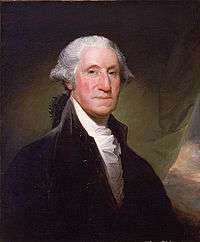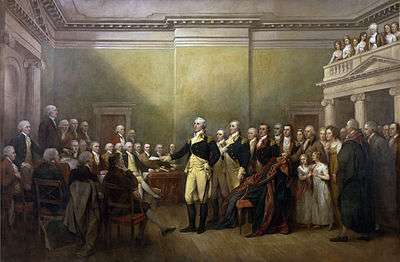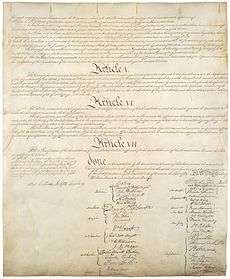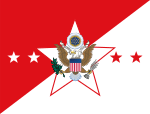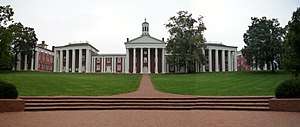George Washington
| George Washington | |
|---|---|
 Portrait by Gilbert Stuart, March 1797 | |
| 1st President of the United States | |
|
In office April 30, 1789[lower-alpha 1] – March 4, 1797 | |
| Vice President | John Adams |
| Preceded by | office established |
| Succeeded by | John Adams |
| Senior Officer of the United States Army | |
|
In office July 13, 1798 – December 14, 1799 | |
| Appointed by | John Adams |
| Preceded by | James Wilkinson |
| Succeeded by | Alexander Hamilton |
|
In office June 15, 1775 – December 23, 1783 Commander-in-Chief of the Continental Army | |
| Appointed by | Continental Congress |
| Preceded by | office established |
| Succeeded by | Henry Knox |
| Delegate to the Continental Congress from Virginia | |
|
In office May 10, 1775 – June 15, 1775 | |
| Preceded by | office established |
| Succeeded by | Thomas Jefferson |
| Constituency | Second Continental Congress |
|
In office September 5, 1774 – October 26, 1774 | |
| Preceded by | office established |
| Succeeded by | office abolished |
| Constituency | First Continental Congress |
| Personal details | |
| Born |
February 22, 1732 Popes Creek, Colony of Virginia, British America |
| Died |
December 14, 1799 (aged 67) Mount Vernon, Virginia |
| Cause of death | Epiglottitis and hypovolemic shock |
| Resting place | Washington Family Tomb, Mount Vernon, Virginia, U.S. |
| Political party | None |
| Spouse(s) | [1] |
| Parents |
Augustine Washington Mary Ball Washington |
| Awards |
Congressional Gold Medal Thanks of Congress |
| Signature |
|
| Military service | |
| Allegiance |
|
| Service/branch |
|
| Years of service |
1752–58 (British Militia) 1775–83 (Continental Army) 1798–99 (U.S. Army) |
| Rank |
Colonel (British Army) General and Commander-in-Chief (Continental Army) Lieutenant General (United States Army) General of the Armies (promoted posthumously: 1976, by an Act of Congress) |
| Commands |
Virginia Colony's regiment Continental Army United States Army |
| Battles/wars | |
|
Other offices held
| |
| ||
|---|---|---|
|
American Revolution Commander in Chief of the President of the United States
First term
Second term
Legacy
|
||
George Washington (February 22, 1732[lower-alpha 2][lower-alpha 3] – December 14, 1799) was one of the Founding Fathers of the United States and served as the nation’s first President (1789–1797). In the American Revolutionary War, General Washington led Patriot forces to victory over the British and their allies. He presided at the Constitutional Convention of 1787 which established the new federal government, and he has been called the "Father of His Country".
Washington was born to a moderately prosperous Virginian family of colonial planters and slaveholders. He had early educational opportunities, learned mathematics, and soon launched a successful career as a surveyor which enabled him to make significant land investments. He then joined the Virginia militia and fought in the French and Indian War. He was appointed commander-in-chief of the Continental Army during the Revolutionary War, leading an allied campaign to victory at the Siege of Yorktown which ended the war. His devotion to Republicanism and revulsion for tyrannical power impelled him to decline further authority after victory, and he resigned as commander-in-chief in 1783.
As the country’s premier statesman, Washington was unanimously elected President by the Electoral College in the first two national elections. He promoted and oversaw implementation of a strong, well-financed national government, using the economic plans of his Treasury Secretary Alexander Hamilton, while remaining impartial in the fierce rivalry between Hamilton and Secretary of State Thomas Jefferson. When the French Revolution plunged Europe into war, Washington assumed a policy of neutrality to protect American ships, while the controversial Jay Treaty of 1795 normalized trade relations with Great Britain. He set numerous precedents that have endured, such as the Cabinet advisory system, the inaugural address, and the title "Mr. President". His seminal Farewell Address strongly warned against political partisanship, sectionalism, and involvement in foreign wars.
Washington owned slaves throughout his life from age 11, but he became increasingly troubled by slavery and freed his slaves in his will. He was a member of the Anglican church and the Freemasons, and he urged tolerance for all religions in his roles as general and President. Upon his death, he was famously eulogized as "first in war, first in peace, and first in the hearts of his countrymen". Washington has been widely memorialized by monuments, art, places, stamps, and currency, and he has been ranked by scholars among the top four American Presidents.
Early years (1732–1752)
George Washington was born February 22, 1732, the first child of Augustine Washington and his wife Mary Ball Washington, at Wakefield on their Popes Creek Estate in the Colony of Virginia. He was a subject of the British Empire at that time, under the reign of George II,[3] descended primarily from the gentry of Sulgrave, England. His great-grandfather John Washington emigrated to Virginia in 1656. He was a tobacco planter who accumulated land and slaves, as did his son Lawrence and his grandson Augustine.[4]
Washington was reared in the rich open farmlands of Virginia's Tidewater region.[5] His father Augustine was a moderately wealthy planter, justice of the peace, and county sheriff who had 10 children, four by his first marriage to Jane Butler and six by his second marriage to Mary.[6] Washington was one of seven surviving children: older half-brothers Lawrence and Augustine, and full siblings Samuel, Elizabeth (Betty), John Augustine, and Charles.[7][lower-alpha 4]
At age 3, Washington and his family moved to Epsewasson, a 2,500-acre plantation which his father purchased on the bluffs of the Potomac River, and they moved to Ferry Farm near Fredericksburg when Washington was 6.[9] He spent much of his boyhood there, and it is said to be the location of the Parson Weems cherry tree legend. Washington's father died at age 48 of a sudden illness on April 12, 1743 when George was 11, and he was then kept under the strict care of his mother Mary.[10] His older half-brother Lawrence inherited Epsewasson and changed the name to Mount Vernon in honor of British Vice Admiral Edward Vernon, his commander during the War of Jenkins' Ear, while Washington inherited Ferry Farm and 10 slaves.[11]
Washington's total education spanned over 8 years, and he was initially taught by his father and Lawrence. He did not attend England's Appleby Grammar School because his mother could not afford the cost,[12] so he was tutored by various masters including Mr. Hobby, his father’s former tenant; he also attended the Fredericksburg school of Anglican clergyman James Mayre.[13] He was taught mathematics, trigonometry, and surveying by school master Henry Williams, and he had a natural talent in draftsmanship and map-making.[14] He purchased books on military affairs, agriculture, and history, as well as popular novels.[15] By early adulthood, he was able to write with precision and considerable force.[16]
Washington's mother rejected a plan for him to join the Royal Navy in September 1746 when he was 14.[17] His half-brother Lawrence had married Anne Fairfax, the daughter of powerful Virginia statesman William Fairfax, in 1743, and he became Washington's idolized surrogate father.[18] Washington moved to Mount Vernon with Lawrence and Ann when he was 17.[19] Washington was close friends with William Fairfax's son George,[20] whose wife Sally had been an early romantic interest; she maintained correspondence with Washington when she moved to England with her father.[21]
Washington and George William Fairfax accompanied surveyor James Genn in 1748 when Washington was 16. Genn had been sent out by Lord Fairfax to survey the Shenandoah lands, and Washington gained valuable experience during the month-long trip.[22] He received a commission and surveyor's license from the College of William & Mary in 1749 when he was 17, and he was appointed surveyor of Culpepper, Virginia due to Fairfax's influence.[23] He primarily surveyed for Lord Fairfax in the Blue Ridge Mountains, after a preliminary survey of eastern Culpepper County.[24] He made repeated surveys of the Shenandoah Valley during the spring of 1750, and he became accustomed to the wilderness. He bought almost 1,500 acres in the Shenandoah Valley in October 1750, his first large land investment, and he accumulated 2,315 acres in the Shenandoah Valley by the time he was 18, when he resigned his commission of Culpepper County surveyor.[25]
Washington stopped surveying within a few years but he continued purchasing land. He acquired more than 70,000 acres in seven states and the District of Columbia over the course of his lifetime; it took him 25 years to expand his Mount Vernon estate from 2,000 to 8,000 acres.[26] He bought more parcels of land to spur development around Federal City (Washington, DC). Rather than selling multiple lots to large investors, he sold individual lots to middle income investors, believing that they were more likely to make committed improvements.[27]
In 1751, Washington made his only trip abroad with Lawrence to Barbados in the hope that the climate would be beneficial to his brother's tuberculosis.[28] During the trip, Washington contracted smallpox which immunized him but left his face slightly scarred.[29] Lawrence's health continued to decline and he returned to Mount Vernon, where he died on July 26, 1752.[30] Washington inherited his Mount Vernon estate after the deaths of Lawrence's wife Ann and their daughter.[31]
Personal life
Washington was generally reserved and somewhat taciturn, yet he had a strong presence among company. He made speeches and announcements when required, but he was not known as an orator or a debater.[32] He was taller than most of his contemporaries;[33] accounts of his height vary from 6 ft (1.83 m) to 6 ft 3.5 in (1.92 m) tall, and he weighed between 210–220 pounds as an adult.[34] He had wide hips, a slim waist, a broad chest, narrow shoulders, muscular thighs, and exceptionally large hands, and he was widely known for his great strength—particularly in his long arms.[35] He had piercing grey-blue eyes, fair skin, and light reddish-brown hair, although he wore his hair powdered in the fashion of the day.[36] He had a rugged and dominating presence which garnered respect from his male peers. However, he suffered frequently from severe tooth decay, and ultimately lost all his teeth but one. He had several sets of false teeth made which he went through during his presidency—none of which were made of wood, contrary to common lore. These dental problems left him in constant pain for which he took laudanum.[37] As a public figure, he demanded that his dentist keep his dental care absolutely private.[38]
Washington was an above-average equestrian early in life. He collected thoroughbreds at Mount Vernon, and his two favorite horses were Blueskin and Nelson.[39] Fellow Virginian Thomas Jefferson said that Washington was "the best horseman of his age and the most graceful figure that could be seen on horseback",[40] and he hunted foxes, deer, ducks, and other game.[41] He was an also excellent dancer and attended the theater frequently. He drank in moderation but was morally opposed to excessive drinking, gambling, tobacco smoking, and profanity.[42]
Colonial soldier (1752–1758)

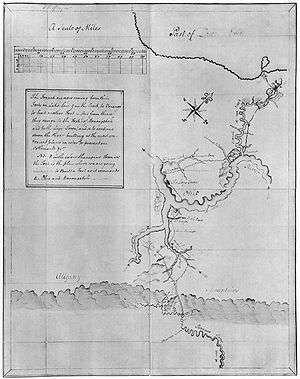
The death of Washington's brother Lawrence left vacant his position as Adjutant General, and Washington began his pursuit of a military life inspired by Lawrence's service.[43] He was trained in musters and drills, then Robert Dinwiddie appointed him adjutant to the Southern district in December 1752; he was subsequently appointed to the Northern and Eastern districts, as well.[15] In February 1753, Dindwiddie appointed him to the rank of Major at an annual salary of 100 pounds, then appointed him as British military ambassador to the French officials and Indians as far north as Erie, Pennsylvania when Washington was 21. Washington would later reflect in amazement three decades later "that so young and inexperienced a person should have been employed" in such negotiations.[44]
The British government had ordered Dinwiddie to guard British territorial claims in the Ohio River basin, protecting trade activity with the Indians and others in the various settlements.[15] Dindwiddie ordered Washington to deliver a letter in late 1753 asking French commander Jacques Legardeur de Saint-Pierre at Fort Le Boeuf to vacate the Ohio Valley, and offering him a safe escort to Lake Erie. Washington was also to make peace with the Six Nations.[45] He and six frontiersmen reached the Ohio River that November, but the French had withdrawn. He met with Tanacharison ("Half-King") and other Six Nations Iroquois chiefs at Logstown and secured their support against the French if needed, and then continued 60 miles (97 km) and met the French at Venango—but the letter was refused. Washington then reached Fort Le Boeuf and delivered the letter to the commander, who replied that Dinwiddie should send his demand to the Major General of New France at its capital in Quebec.[46] Washington’s diary of the expedition was printed by William Hunter according to Dinwiddie’s order, giving Washington name recognition in Virginia and England;[47] it also helped him obtain a commission to raise a company of men.[48]
French and Indian War
In 1753, the French military advanced into the Ohio Country, territory that both France and Britain wanted to claim. Virginia's Ohio Company was created to encourage British settlement of the land; it had an economic interest in the region, and both Dinwiddie and Washington were stockholders. The land which joined the Monongahela and Allegheny rivers (modern Pittsburgh) was highly prized by both nations,[49] and the competing stakes led to the French and Indian War (1754–62) and contributed to the start of the global Seven Years' War (1756–63). It was Washington who ordered the first shot fired in that war in 1754.[50]
On March 15, 1754, Governor Dinwiddie commissioned Washington Lieutenant Colonel in the newly formed Virginia Regiment at age 21 and sent him to confront French forces at Pittsburgh. Dindwiddie ordered Washington to take prisoners or kill those who resisted British control of the region.[49] He set out on April 2 with 150 men, and received news en route that a French force had driven out colonial traders and begun construction of Fort Duquesne. Tanacharison and a few warriors discovered a small detachment of French troops east of Uniontown, Pennsylvania led by Joseph Coulon de Jumonville, so Washington built an entrenched camp at Great Meadows which he called Fort Necessity. He then led his unit and their Mingo allies in an ambush against the French on May 28 in the Battle of Jumonville Glen.[47] There are discrepancies, but primary accounts indicate that the battle lasted about 15 minutes. Jumonville was killed and most of his party were taken prisoner or killed, and Tanacharison nicknamed Washington the "Town Destroyer".[51]
In July 1754, the French responded by attacking Fort Necessity in a ten-hour battle which ended in Washington's only surrender and the return of his force to Virginia—but only after he signed a falsely translated surrender document saying that he had "assassinated" Jumonville,[52][53] and this mistranslated document became the pretext to blame him for starting a war.[52] Historian Joseph Ellis concludes that the episode demonstrated Washington's bravery and initiative, as well as his inexperience and impetuosity.[54] Upon his return to Virginia, Washington refused to accept a demotion to the rank of captain and resigned his commission.[55] This expedition into the Ohio Country had international consequences. The French accused him of assassinating Jumonville, claiming that Jumonville was only on a diplomatic mission.[54] Both France and Great Britain were set to fight for control of the region, both sending in troops in 1755, and war was formally declared in 1756.[56]
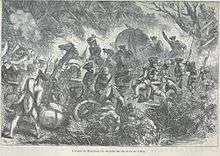
In 1755, the British Crown sent General Edward Braddock and regulars to take Fort Duquesne.[57] This was the largest British expedition to the colonies, intended to expel the French from the Ohio Country.[58] Braddock offered Washington the position of aide on his staff, and he accepted.[57] Washington recommended that Braddock split the army into two divisions with a primary column and a second, more lightly equipped mobile offensive "flying column".[59] During the march, Washington became severely ill and was left behind, but he was able to rejoin Braddock at Monongahela. The next day, the French and their Indian allies ambushed Braddock's divided forces, and Braddock was mortally wounded.[59] The British suffered devastating casualties and retreated in panic, with two-thirds killed or wounded, but Washington rallied his forces in an organized retreat even though he was suffering from a fever and headache.[60] He had two horses shot from under him, and his hat and coat were bullet-pierced.[57] His conduct under fire redeemed his reputation among critics of his command in the Battle of Fort Necessity.[61] Nonetheless, he was not included by the succeeding commander Colonel Thomas Dunbar in planning subsequent operations.[60]
On August 14, 1755, Dinwiddie appointed Washington colonel and commander in chief of all of Virginia's colonial military forces, to protect Virginia's frontier from Indian attacks.[62] Washington was 23, in charge of defending 300 miles with only 300 men. [62] Savage frontier battles took place, 20 battles in 10 months between Washington's Virginia Regiment and the Indians.[63] Washington desired to wear the coveted red coat of officer rank, but this eluded him. He was convinced that Braddock would have recommended him for a regular commission in the British army had he survived, so he appealed to Braddock's successor Lord Loudoun.[64] Loudon refused the request but did agree to transfer responsibility for Fort Cumberland from Virginia to Maryland.[64] Washington's command increased to a thousand soldiers, while he emphasized discipline and training, and Virginia's frontier population suffered less than that of other colonies as a result of his strenuous efforts. Ellis concludes that "it was his only unqualified success" during the French and Indian War.[65]

Washington continued to advocate the capture of Fort Duquesne,[66] and the British crown sent Commanding General John Forbes, Colonel Thomas Gage, and British regulars to take the post in 1758.[66] Washington was promoted honorary Brigadier General, while he and two regiments under his command were ordered to cooperate.[67] During the Forbes Expedition, Washington suggested using an Indian-style warfare method, but this was ignored.[68] Washington was the only colonial officer among the British forces and was involved in only one battle during the campaign.[66]
Forbes had devised a plan for an assault on Fort Duquesne and assigned Washington to lead one of three brigades. He was alerted to an enemy reconnaissance party in the area and sent Colonel George Mercer and a contingent of several hundred Virginians to investigate. Gunshots were heard in the distance and Washington's unit responded, but they found themselves in a friendly-fire situation when reinforcements also arrived, each contingent thinking that the other was the French enemy. This incident resulted in minor casualties.[69]
Forbes assembled 2,500 men in late November for the final assault on the fort, and he promoted Washington to honorary brigadier general to head the operation. Washington and his army arrived on November 25 to find the fort abandoned and burned.[70] The British did score a strategic victory by gaining control of the Ohio Valley, but Washington retired from his Virginia Regiment commission in December 1758 and returned to Mount Vernon, while the French and Indian War was concluded in 1763 by the Treaty of Paris.[71] Washington never gained the Royal commission which he sought, but he acquired military, political, and leadership skills which proved invaluable during the American Revolution.[72] Historians ascribe his support of a strong national government and a vigorous executive to his frustrations with officials in these and later interactions.[73][74][lower-alpha 5] He developed a distinct preference for regular troops over undisciplined militia, even though his command was limited during this war to smaller and more rural forces than during the Revolution.[76][77]
Religion and the Enlightenment
Washington's religious views were complex. He was descended from Anglican minister Lawrence Washington, whose troubles with the Church of England may have caused his heirs to emigrate to America.[78] He was a devoted member of the Anglican Church and was baptized as an infant in April 1732.[79] He served as a vestryman and as church warden for Fairfax Parish in Alexandria and Truro Parish, posts that he maintained for 22 years.[80] He privately prayed and read the Bible daily, and he publicly encouraged people and the nation to pray.[81] He may have taken communion on a regular basis prior to the Revolutionary War, but he did not do so following the war, and Pastor James Abercrombie admonished him for not setting an example.[82]
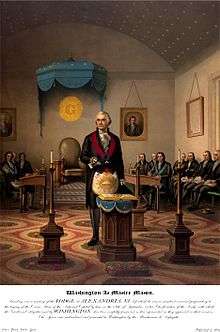
Washington believed in a "wise, inscrutable, and irresistible" Creator God who was active in the Universe.[78] He referred to this God by the Enlightenment terms Providence, The Creator, or The Almighty.[83] He believed in a divine power who watched over battlefields, was involved in the outcome of war, was protecting his life, and was involved in American politics—specifically the creation of the United States.[84] Historian Ron Chernow suggests that Washington avoided evangelistic Christianity or hellfire and brimstone speech, as well as communion or anything that would "flaunt his religiosity". Chernow points out that he "never used his religion as a device for partisan purposes or in official undertakings".[85] No mention of Jesus Christ appears in his private correspondence, and such references are rare in his public writings.[86] He often quoted from the Bible or paraphrased it, and often referred to the Anglican Book of Common Prayer.[87] There is debate on whether he is best classed as a Christian, a theistic rationalist, or both.[88]
Washington emphasized religious toleration in a nation with numerous denominations and religions; when referring to God, he would use terms such as, Creator, Divine Author, and Supreme Being.[89] He attended services of different Christian denominations and suppressed anti-Catholic celebrations in the Army.[90] He permitted Jews, Muslims, Christians of any denomination, and atheists to work at Mount Vernon. While President, he saluted 22 major religious sects and gave speeches on religious toleration.[91] He was deeply rooted in the ideas, values, and modes of thinking of the Enlightenment, more so than his contemporaries.[92] He harbored no contempt of organized Christianity and its clergy, "being no bigot myself to any mode of worship".[92] He proclaimed in 1793, "We have abundant reason to rejoice that in this Land the light of truth and reason has triumphed over the power of bigotry and superstition."[93]
Washington became a member of the Freemasons, more commonly known as the Masonic Lodge. It was a socially acceptable institution in the late 18th century which advocated moral teachings.[94] He was attracted by the Masons' dedication to the Enlightenment principles of rationality, reason, and brotherhood. The American lodges did not share the anti-clerical perspective of the controversial European lodges.[95] A Masonic lodge was established in Fredericksburg, Virginia in September 1752 and he was initiated two months later as one of its first Entered Apprentices. Within a year, he progressed through its ranks to become a Master Mason.[96] Before and during the American Revolution, he used Masonic lodges as meeting places to plot against the British.[97] He had a high regard for the Masonic Order, but his personal lodge attendance was sporadic. In 1777, a convention of Virginia lodges asked him to be the Grand Master of the newly established Grand Lodge of Virginia, but he declined due to his commitment leading the Continental Army. After 1782, however, he corresponded frequently with Masonic lodges and members.[97] In 1788, he was listed as Master in the Virginia charter of Alexandria Lodge No. 22.[98]
Marriage and civilian life (1759–1774)

Washington married Martha Dandridge Custis on January 6, 1759, the wealthy widow of Daniel Parke Custis. He was 27 and she was 28, and the ceremony took place at the Custis mansion. Martha was intelligent, gracious, and experienced in managing a planter's estate, and they made a harmonious marriage.[99] They raised John Parke Custis and Martha Parke (Patsy) Custis, her children from her previous marriage, and they later raised their grandchildren Eleanor Parke Custis and George Washington Parke Custis. They had no children together; his 1751 bout with smallpox may have made him sterile, and he grieved privately over not having his own children.[100] They moved to Mount Vernon near Alexandria where he took up life as a successful planter of tobacco and wheat and emerged as a political figure.[101]
Washington’s marriage also made him one of Virginia's wealthiest men and increased his social standing. He acquired control over Martha’s one-third dower interest in the 18,000-acre (73 km2) Custis estate, worth approximately $100,000, and he managed the remaining two-thirds on behalf of Martha's children.[102] He also acquired 84 slaves through the marriage, brought to Mount Vernon from the estate.[103]
Dinwiddie had promised land bounties in 1754 to the soldiers and officers who volunteered during the French and Indian War;[104] Washington prevailed upon Governor Lord Botetourt, and he fulfilled Dinwiddie's promise in 1769–70.[105] Washington received title to 23,200 acres (94 km2) where the Kanawha River flows into the Ohio River in West Virginia;[106] he also bought additional land, doubled the size of Mount Vernon to 6,500 acres (26 km2), and increased its slave population to more than 100 by 1775.[107]
As a respected military hero and landowner, he held local office and was elected to the Virginia provincial legislature, representing Frederick County in the House of Burgesses for seven years beginning in 1758.[107] In the election that year, he plied the voters with 170 US gallons (640 l) of rice punch, beer, wine, hard cider, and brandy while he was away serving on the Forbes Expedition.[108] He won election with roughly 40 percent of the vote, defeating three other candidates with the help of several local elites. He rarely spoke publicly in his early legislative career, but he became a prominent critic of Britain's taxation and mercantilist policies in the 1760s.[109]

Washington lived an aristocratic lifestyle, and his favorite activities included fox hunting, fishing, dances and parties, the theater, races, and cockfights. He also was known to play cards, backgammon, and billiards.[110] Like most Virginia planters, he imported luxuries and other goods from England and paid for them by exporting his tobacco crop. By 1764, however, a poor tobacco market left him ₤1,800 in debt.[111] He bolstered his solvency in the mid-1760s by diversifying, paying more attention to his finances, and reducing imported luxuries. He changed Mount Vernon's primary cash crop from tobacco to wheat, and he further diversified operations to include flour milling, fishing, horse breeding, hog production, spinning, and weaving.[112] In the 1790s, he erected a distillery for whiskey production which yielded more than 1,000 US gallons (3,800 l) a month.[113]
In the fall of 1770, Washington inspected the bounty lands in the Ohio and Great Kanawha regions, promised to French and Indian War veterans. He secured the appointment of William Crawford to make a survey of the lands, who gave Washington the best acreage on the tract. Washington told the veterans that their land was hilly and unsuitable for farming, and agreed to purchase 20,147 acres; many veterans were happy with the sale, while others felt they had been duped.[114]
Washington's step-daughter Patsy Custis died in his arms on June 19, 1773 after suffering from epileptic attacks for five years. The following day, he wrote to Burwell Bassett: "It is easier to conceive, than to describe, the distress of this Family…."[115] He cancelled all business activity and was not away from Martha for a single night for the next three months.[116] Patsy's death enabled him to pay off his British creditors, however, since half of her inheritance passed to him.[117]
Washington became a political figure and soon emerged as a leader among the social elite in Virginia. From 1768 to 1775, he invited some 2,000 guests to his Mount Vernon estate, mostly those whom he considered "people of rank". His advice regarding people who were not of high social status was to "treat them civilly" but "keep them at a proper distance, for they will grow upon familiarity, in proportion as you sink in authority".[118] He became more politically active in 1769, presenting legislation in the Virginia Assembly to establish an embargo on goods from Great Britain.[119]
American Revolution
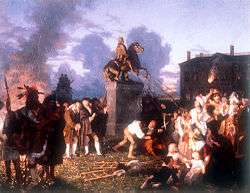
Washington played a leading political and military role in the American Revolution. His sense of diffidence towards England began when he was passed over for a commission in the British Army in 1755.[120] He and other colonists were angered by a Royal Proclamation in 1763 which banned American settlement west of the Alleghany Mountains, in order to protect the British fur trade.[121][lower-alpha 6] He believed that the Stamp Act of 1765 was an "Act of Oppression", and he celebrated with his fellow colonists after its appeal the following year.[123][lower-alpha 7] In March 1766, Parliament passed the Declaratory Act which asserted that Parliamentary law held absolute sway over colonial law.[125] Washington helped to lead the widespread colonial protests against the Townshend Acts passed by Parliament in 1767, and he introduced a proposal in May 1769 drafted by George Mason which called for Virginia to boycott English goods until the Acts were repealed. Parliament repealed them in 1770.[126]
Parliament instituted the Intolerable Acts in 1774 as punitive measures for the Boston Tea Party, and Washington referred to them as "an Invasion of our Rights and Privileges".[127] He said that Americans must not submit to acts of tyranny since "custom and use shall make us as tame and abject slaves, as the blacks we rule over with such arbitrary sway".[128] In July 1774, George Mason arrived at Mount Vernon with a list of resolutions which he and Washington worked overnight to refine. The next day, they presented them to the Fairfax County committee, chaired by Washington, which adopted the Fairfax Resolves calling for a Continental Congress, among other things.[129] In August, he attended the First Virginia Convention where he was selected as a delegate to the First Continental Congress.[130] On July 4, 1776, the Second Continental Congress signed the Declaration of Independence from Britain. Patriots openly attacked symbols of monarchy and toppled an equestrian statue of George III in New York City five days later.[131]
Revolutionary War (1775–1783)
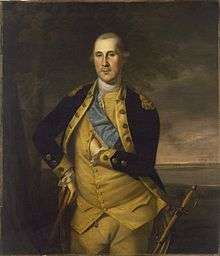
The Revolutionary War with Great Britain began April 19, 1775 at the Battles of Lexington and Concord, while the Continentals besieged the British in Boston.[132] The Second Continental Congress in Philadelphia officially assumed command of the troops in Boston on June 14 and created the Continental Army. Samuel Adams and John Adams passed over John Hancock to nominate Washington as supreme commander, and he was unanimously elected the next day.[133]
Washington appeared at the Congress, poised for war in a military uniform.[134] He declined a salary in his acceptance speech but received reimbursement of expenses for which he fully accounted.[135] The Patriot Continental Congress chose capable subordinate officers to aid him, including Major General Artemas Ward, Adjutant General Horatio Gates, Major General Charles Lee, Major General Philip Schuyler, Major General Nathanael Greene, Colonel Henry Knox, and Colonel Alexander Hamilton.[136] Washington was impressed by the enthusiasm of Colonel Benedict Arnold and gave him the responsibilities of invading Canada. He also engaged Brigadier General Daniel Morgan with whom he had served in the French and Indian War.[137]
On July 2, 1775, Washington inspected his new army at Cambridge, Massachusetts and was astonished to find a ragtag assembly of undisciplined, poorly sheltered, and badly outfitted soldiers.[138] He formally took command on July 3 and immediately initiated reforms. He drilled soldiers and imposed strict discipline, including fines, floggings, and incarceration.[139] He ordered his officer staff to familiarize themselves with their recruits so as to understand the military duties best suited to them, to respect civilians, and to read military manuals.[140] He removed cowardly or incompetent officers, and he told Congress that it was a "most necessary Work".[141] On August 23, King George III proclaimed that rebellious American colonists were traitors.[142]
Quebec, Boston, and Long Island
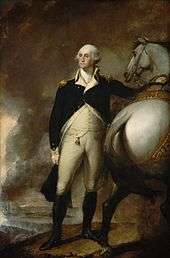
In September 1775, Washington sent staff officer Arnold and 1,000 troops to Canada to aid General Richard Montgomery's siege of British-held Quebec and to secure the northern flank.[143] Quebec was reinforced by 7,000 British troops and the American siege collapsed, forcing the Continental Army to make a hasty retreat.[144] Later that month, an impatient Washington called a council of war and proposed an attack on the besieged British Army in Boston.[145] However, his generals declined the ambitious plan, concerned about high casualties on an entrenched enemy.[146]
Washington started afresh with new recruits in January 1776, since soldiers left the Army after their enlistments expired.[142] By mid-January, his army was half-strength at 9,600 men, and the colonial militia who fought in the French and Indian War were summoned to fill in the gaps.[147][lower-alpha 8] The new British commander at Boston was General William Howe, but he did not attack during this time—which was probably fortunate for Washington and the burgeoning Continental Army.[145]
In late 1775, Washington sent staff officer Henry Knox to the recently captured Fort Ticonderoga for gunpowder and cannons. He transported them to Dorchester Heights in February where he was joined by Washington, who used them to drive the British out of Boston. General Howe immediately evacuated Boston with 10,000 troops and 1,100 loyalists. Washington then marched his Army to New York, initiated fortification, and correctly predicted that the British would return and attack in full force.[149]
Howe resupplied in Nova Scotia and headed for New York City with the British fleet, as it was considered the key to securing the continent. The British forces assembled in New York Bay, including more than 100 ships and thousands of troops.[150] Howe's army landed unopposed on Staten Island on July 2, and British ships continued to arrive from England and Carolina for a siege of the city.[151] Howe's troop strength totaled 32,000 well-trained soldiers, including 8,000 Hessians, while Washington's troop strength consisted of 23,000 soldiers, 19,000 of whom were raw recruits and militia.[152] On August 22, Howe landed 20,000 troops at Gravesend, Brooklyn and approached Washington's fortifications. Washington chose to fight despite the objections of his generals,[153] as he had received false information that Howe's army had only 8,000 to 9,000 troops.[154] Howe assaulted Washington's flank on August 27 and inflicted 1,500 Patriot casualties, while the British suffered 400 casualties.[155] Washington and his generals decided to retreat, and he instructed General William Heath to make available every flat-bottomed riverboat and sloop in the area. General William Alexander held off the British Army and covered the retreat, and the army safely crossed the East River under the cover of darkness to Manhattan Island without loss of life or material——although the British captured General Alexander.[156]
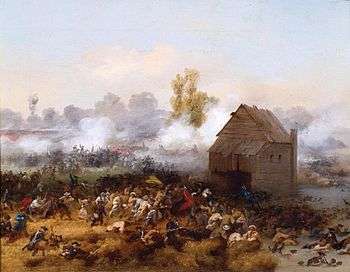
Alonzo Chappel (1858)
Howe was emboldened by his victory at Long Island and sent a dispatch addressed to "George Washington, Esq." attempting to negotiate peace. Washington declined the overture and demanded that he be addressed as a General and recognized as a fellow belligerent, not as a "rebel". He was concerned that his men would be hanged as rebels if they were captured, and he believed it his duty to insist that his men and the newly established United States be recognized with proper diplomatic protocol. The attempts at negotiation failed.[157]
The British navy bombarded unstable earthworks on lower Manhattan Island that had been constructed by the Patriots.[158] Washington considered abandoning the island, including Fort Washington, but he heeded the advice of Generals Greene and Israel Putnam to defend the fort. They were unable to hold it, however, and Washington abandoned it despite General Lee's objections; his army retired north to White Plains.[159] Howe pursued, and Washington was forced to retreat across the Hudson River to Fort Lee and avoid encirclement. Howe took the offensive; he landed his troops on the island on November 16, surrounded and captured Fort Washington, and inflicted high casualties on the Americans. Washington was responsible for the decision to delay the retreat, but he also faulted the Congress and Nathaniel Greene. Loyalists in New York considered Howe a liberator and spread a rumor that Washington had set fire to the city.[160] The morale in the Patriot army was at its lowest ebb, as the British captured General Lee while he was with his mistress.[161]
Delaware crossing, Trenton, and Princeton
_-_Washington_Crossing_the_Delaware_-_Google_Art_Project.jpg)
Washington's Patriot army retreated through northeast New Jersey, reduced to 5,400 troops.[163] Howe broke off pursuit on December 14, delayed his advance on Philadelphia, and set up winter quarters in New York.[164] Washington crossed the Delaware River, while Lee's replacement John Sullivan and 2,000 troops joined him in Pennsylvania.[165] The future of the Continental Army was in doubt due to lack of basic supplies, expiring enlistments, and desertions. Washington was disappointed that many New Jersey residents were revealed to be Loyalists, or simply skeptical about the prospect of Independence.[166] Howe had split up his British Army and posted a Hessian garrison at Trenton, New Jersey to hold western New Jersey and the east shore of the Delaware.[167]
Washington learned of the complacency of Howe and his Hessian mercenaries, and he was facing desperate conditions and diminishing numbers, so he met with his generals on Christmas Eve and devised a plan to cross the icy Delaware at night and to surprise the enemy. Washington himself crossed the river in advance and staked out a landing zone for his troops on the New Jersey shore. He then ordered a 60-mile search for barges along the Delaware to transport his army, particularly Durham boats,[lower-alpha 10] and he ordered them to destroy any vessels that could be used by the British.[169] With his plan on the verge of failure, he led the army across the Delaware on the night of December 25–26, 1776 with 18 pieces of artillery, struggling with rapid currents and with ice hindering their way.[170]
Washington had divided his forces into three groups with Washington leading the first group. The American troops crossed that evening, shortly after dusk, in heavy sleet and snow. The two other groups were delayed due to problems with managing frightened horses and transporting the artillery, which required flat bottom ferries. Waiting for the rest of the Army to make the crossing Washington sat and waited in despair, fearing that he might have to abandon his attack on Trenton.[171]. Scouts reported the location of the Hessian forward positions about one mile from Trenton. After the rest of the army made it across, Washington now divided the army into two groups and rode about giving words of encouragement to his men: "Soldiers keep by your officers. For God's sake, keep by your officers." He stopped briefly at a nearby home while his senior officers gathered for a council of war. Moving on, the two divisions separated at the Birmingham crossroads, with General Nathanael Greene's division taking the upper Ferry Road, led by Washington, while General John Sullivan's advanced on River Road.[172] (See map) As the Americans approached Trenton, the 1,200 Hessian garrison was sleeping after celebrating Christmas parties. In coordinated effort, the army advanced on Trenton in a surprise attack at about 8 a.m., still dark from heavy cloud cover. Washington personally led the charge, aided by Major-General Henry Knox and his artillery, and captured some 850 troops[173] with Hessian Colonel Johann Rall mortally wounded during the short battle.[174]

John Trumbull
Washington captured many British and Hessian troops and large amounts of supply and retreated back across the Delaware to Pennsylvania. On January 3, he returned to New Jersey and launched an attack on British regulars at Princeton, with only 40 Americans killed or wounded while the British forces suffered 273 killed or captured.[175] American Generals Hugh Mercer and John Cadwalader were already present and being driven back by the British, then Mercer was mortally wounded. Washington arrived at the scene and rallied the men to counterattack, himself out front and advancing to within 30 yards of the British line.[176] The remaining British troops retreated after making a brief stand, some evacuating Princeton and others taking refuge in Nassau Hall. Alexander Hamilton brought three cannons and began firing at the building where the British were holed up. Washington's troops charged, and in less than an hour the British put out the white flag of surrender; 194 soldiers walked out of the building and laid down their arms.[177] Howe retreated to New York City and its environs, where his army remained inactive until Spring.[178] Washington's depleted Continental Army took up winter headquarters in Morristown, New Jersey, allowing them to disrupt British supply lines and drive the British from parts of New Jersey. He later admitted that the British could easily have defeated his thinly guarded encampment if they had counter-attacked before his troops were dug in.[179]
Washington's victories were pivotal for the revolution and wrecked the British strategy of showing overwhelming force, then offering generous terms.[180] Meanwhile, the British still controlled New York[178]. After the winter campaign, however, many Patriot soldiers did not re-enlist or had deserted during the harsh winter. Washington and Congress responded with increased rewards for re-enlisting and punishment for desertion, which effected greater troop numbers for later battles.[181] In the last two weeks of February, 1777, word reached London of Washington's victories at Trenton and Princeton, bringing with it the realization that the Americans were now in a position to demand complete independence with no conditions.[182]
Brandywine, Germantown, and Saratoga
The Americans were encamped at Morristown, New Jersey in February 1777, and Washington became convinced that smallpox inoculation was required to prevent the destruction of his Army; this drastically reduced deaths by the disease, according to some accounts.[183] That summer, British General John Burgoyne led a major invasion army south from Quebec, planning to sever New England. But General Howe, in British occupied New York[178], made a strategic blunder and took his army south to Philadelphia instead of going up the Hudson River to join Burgoyne near Albany. Meanwhile, Washington rushed to Philadelphia to engage Howe, while he closely supervised the action in upstate New York where the Patriots were led by General Philip Schuyler and his successor Horatio Gates. The pitched battles at Philadelphia were too complex for Washington's less experienced men, and they were defeated.[184]
Howe outmaneuvered Washington at the Battle of Brandywine on September 11, 1777, and he marched unopposed into the American capital at Philadelphia. Washington's army unsuccessfully attacked the British garrison at Germantown in early October, and his loss at Philadelphia prompted some members of Congress to consider removing him from command. His supporters rallied behind him, referred to as the Conway Cabal, and the attempt failed.[185]
Meanwhile, Washington's strategy improved the situation for Gates' army during the Saratoga campaign to the north. He was most concerned about the movements of General Howe and was aware that Burgoyne was also moving south toward Saratoga from Quebec. He took some risks in July and sent reinforcements north commanded by Major General Benedict Arnold, his most aggressive field commander, and Major General Benjamin Lincoln. Burgoyne made two attempts to take Bemis Heights, then found himself trapped and beyond the reach of help from Howe. He was forced to retreat to Saratoga and ultimately surrendered after the Battles of Saratoga, which led to Howe's resignation in May 1778. This was a major turning point militarily and diplomatically; the French responded to Burgoyne's defeat by entering the war, allying with America and expanding the Revolutionary War into a worldwide affair (from the perspective of the British).[186]
Washington was concerned that Gate's victory was going to give impetus to his critics.[187] Biographer Alden suggests that "it was inevitable that the defeats of Washington's forces and the concurrent victory of the forces in upper New York should be compared." The zealous admiration of Washington waned, with John Adams giving him little credit. [188]
Valley Forge, Monmouth, and Southern campaigns
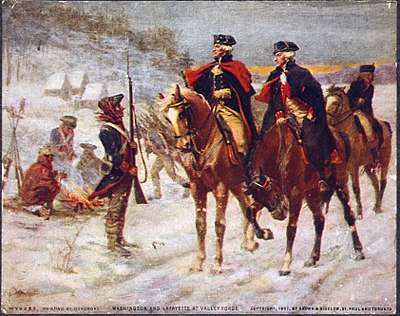
John Ward Dunsmore (1907)
Washington's army of 11,000 went into winter quarters at Valley Forge north of Philadelphia in December 1777 and suffered thousands of deaths over the next six months. Most were from disease, compounded by lack of food and proper clothing, poor shelter, and the extreme cold. Historians’ estimates range from 2,000 to more than 3,000 men lost.[189] The British, by contrast, were comfortably quartered in Philadelphia; they paid for their supplies in pounds sterling, while Washington had difficulty procuring supplies with depreciating American paper currency. The woodlands were soon exhausted of game, and Washington was faced with the task of maintaining morale and discouraging desertion by February.[190]
Washington had repeatedly petitioned the Continental Congress for badly needed provisions but without success. Finally, five Congressmen came to Valley Forge on January 24, 1778 to check the conditions of the Continental Army. Washington expressed the urgency of the situation, exclaiming, "Something must be done. Important alterations must be made." He also recommended that Congress take control of the army supply system, pay for supplies, and hasten them to the troops. In response to his urgent appeal, Congress gave full support to funding the supply lines of the army, which also resulted in reorganizing the commissary department which gathered the supplies for the army. By late February, there were adequate supplies arriving at the camp.[148]

Emanuel Leutze (1851–1854)
Washington recruited men into the regular army and assigned their training to Baron Friedrich Wilhelm von Steuben, whose incessant drilling soon transformed them into a disciplined fighting force.[191] Washington's army had endured the winter that many feared would dissolve it, and a revitalized army emerged from Valley Forge the following spring.[192] Von Steuben was promoted to Major General for his effort and became Washington's chief of staff for the rest of the war.[193]
In May 1778, the Continental Congress ratified the Treaty of Alliance with King Louis XVI of France which allied the French military and navy with America.[194] The British evacuated Philadelphia for New York in June 1778, and Washington summoned a council of war with Generals Lee, Greene, Wayne, and Lafayette. He chose a partial attack on the retreating British at the Battle of Monmouth; the British were commanded by Howe's successor General Henry Clinton. Lee and Lafayette moved with 4,000 men and bungled their first attack on June 28, without Washington's knowledge. Washington relieved Lee and continued fighting to an effective draw in one of the war's largest battles. Nightfall came and the British continued their retreat to New York, where Washington moved his army outside the city.[195] Monmouth was the last major battle that Washington fought in the north; he deemed it more important to protect his army than to keep the British from occupying towns which rarely had anything to offer the British army.[196]
In late 1778, General Clinton sent 3,000 troops by ship from New York to Georgia and launched a Southern invasion. [197] He seized Savannah, reinforced by 2,000 British and Loyalist troops, and repelled an attack by Patriots and French naval forces.[197] The success bolstered the British War effort.[197] Clinton assembled 12,500 troops and attacked Charlestown in January 1780, defeating General Lincoln who only had 5,100 Continental troops.[198] The British went on to occupy the South Carolina Piedmont in June, with almost no Patriot resistance.[198] Clinton returned to New York and left 8,000 troops commanded by Lord Cornwallis.[199] Congress replaced Lincoln with Gates, despite Washington's recommendation of Greene. Gates failed in South Carolina and was replaced by Greene, and the British had the South in their grasp. Despite this bleak situation, Washington was encouraged when he learned in mid-1780 that Lafayette had returned from France with more ships, men, and supplies.[200]
Sullivan expedition and Hudson River
In the summer of 1779, Washington and Congress decided to strike the Iroquois warriors of the "Six Nations" in a campaign to force Britain's Indian allies out of New York, which they had used as a base to attack American settlements around New England.[201] The Indian warriors joined with Tory rangers led by Walter Butler and slew more than 200 frontiersmen in June, using barbarities normally shunned, and they laid waste to the Wyoming Valley in Pennsylvania.[202] Washington ordered General John Sullivan to lead a military operation in August, prompted by massacres and many attacks on American civilians, and to affect "the total destruction and devastation" of all Iroquois villages and to take their women and children as hostages. Those who managed to escape fled to British protection in Canada.[203] Sullivan later reported that the expedition had been accomplished, referring to the Iroquois as "inhuman barbarians".[204]
Washington went into quarters at Morristown, New Jersey during the harsh winter of 1779–80, which subjected the troops to some of the worst suffering during the war with temperatures well below freezing. New York Harbor was frozen over, and snow and ice covered the ground for weeks, with the troops again lacking provisions for a time as at Valley Forge.
West Point espionage
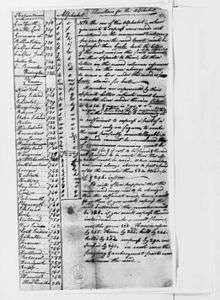
Washington had worked hard to develop a successful espionage system to detect British locations and plans, and he has been called "Americas First Spymaster".[205] In 1778, he ordered Major Benjamin Tallmadge to form the Culper Ring to collect information about the British in New York.[206] He was usually mindful of treachery, but he ignored incidents of disloyalty by Benedict Arnold, his admired and trusted officer who had distinguished himself in many battles.[207]
Arnold and his wife Peggy met with Philadelphia merchant Joseph Stransbury in early May 1779 to discuss defection, and Stransbury secretly relayed this information to British spymaster John André in New York on May 10.[208] Historians have suggested several factors which might have motivated Arnold to commit his betrayal. He received a £6,000 British payment; he was angry at losing promotions to junior officers and at the repeated slights from Congress;[209] he was profiteering from the war and faced a court martial for it; and he was deeply in debt.[210]
During the summer of 1780, Arnold began his plot of treason, supplying André with sensitive information intended to compromise Washington and capture West Point, a key American defensive position on the Hudson River.[211] Arnold repeatedly asked for command of West Point, and Washington finally relented and gave it to him in August.[212] Arnold met André on the banks of the Hudson on September 21 and gave him the plans to take over the garrison;[213] but André was captured by militia forces who discovered Arnold's plans, and Arnold took flight on horseback and escaped to New York.[214] Upon receiving the news, an outraged Washington immediately recalled all the commanders under Arnold at key positions around the fort as a precaution against any complicity on their part; however, he did not suspect Arnold's wife at this time.[215] Washington assumed personal command of West Point and worked earnestly reorganizing the order of command and strengthening defensive positions.[216]
André was tried by a military court for spying and was sentenced to death. Washington offered to return him to the British in exchange for Arnold, but Clinton refused. André then asked Washington to be executed by firing squad, and Washington was inclined to grant his wish; but he changed his mind under pressure to make an example of the enemy spymaster. André was hanged in Tappan, New York on October 2, 1780.[217]
Yorktown victory, peace treaty, and resignation
Washington's army went into winter quarters at New Windsor, New York in 1780 and suffered again from extreme cold and lack of supplies, prompting Washington to prevail upon Congress and state officials to come to their aid with provisions. He sympathized with their suffering, saying that he hoped that the army would not "continue to struggle under the same difficulties they have hitherto endured".[218]
In July 1780, 5,000 veteran French troops led by the comte de Rochambeau arrived at Newport, Rhode Island.[219] French naval forces then landed, led by Admiral François Joseph Paul de Grasse, and Washington encouraged Rochambeau to move his fleet south, to launch a joint land-naval attack on Arnold's troops.[220]
%2C_rev%C3%AAtu_du_grand_costume_royal_en_1779_-_Google_Art_Project.jpg)
Arnold was now a Brigadier General in the British Army, and General Clinton sent him to Virginia with about 1,700 troops to capture Portsmouth and spread terror throughout the state; Washington responded by sending Lafayette south with a small army to counter Arnold's efforts.[221] At first, Washington hoped to bring the allied fight to New York, drawing off British forces from Virginia and ending the war there, but Rochambeau advised de Grasse that Cornwallis in Virginia was the better target. Admiral de Grasse followed this advice and arrived with his fleet off the Virginia coast. Washington immediately saw the advantage created, made a feinting move with his force towards Clinton in New York, and then headed south to Virginia.[222]
Washington's Continental Army delivered the last blow in 1781, bolstered by $20,000 in French gold and troops. The French won a naval victory in the Battle of the Chesapeake, allowing Patriot forces to trap the British army in Virginia and prevent reinforcement by Clinton from the North,[223] and the surrender at Yorktown on October 19, 1781 marked the end of major fighting.[224] Washington took great satisfaction in the surrender but displayed no outward sign.[225] Cornwallis failed to appear at the official surrender ceremony, claiming illness; he sent General Charles O'Hara as his proxy. Washington then had General Benjamin Lincoln accept the surrender in his place.[226]
Decisive combat had ended, and British troops began to demobilize months after Yorktown, while peace negotiations started.[227] The British evacuated 2,000 troops from Savannah in July 1782 and 4,000 from Charles Town in December.[228] They removed 18,000 troops from New York throughout the Spring, Summer, and Fall of 1783,[229] and the French army and navy departed. The American treasury was empty, and unpaid soldiers were restive to the point of mutiny and forced an adjournment of the Congress. Washington dispelled unrest among officers by suppressing the Newburgh Conspiracy in March 1783, and Congress promised the officers a five-year bonus.[230] Washington later submitted a formal detailed account of about $450,000 in military expenses that he advanced to the army in his tenure. It was allegedly vague about large sums, and included wife Martha's expenses incurred in visits to his headquarters as well as his agreed compensation.[231]
With the peace treaty initially ratified in April 1783, a Congressional committee under Hamilton was arranging a peacetime army. On May 2, 1783, Washington submitted the Army’s position to the Committee in his Sentiments on a Peace Establishment.[232] The Committee’s proposals were defeated in Congress by votes taken in May 1783, October 1783, and April 1784.[233] The Treaty of Paris was signed on September 3, 1783, and Great Britain officially recognized the independence of the United States. Washington disbanded his army and gave an eloquent farewell address to his soldiers on November 2.[234] On November 25, the British evacuated New York City, and Washington and the governor took possession. Only a few trusted members of Congress, including Jefferson, knew of Washington's decision to resign his commission as Commander-in-chief.
Washington bade farewell to his officers at Fraunces Tavern on December 4, 1783[235] and resigned his commission on December 23, after leading the Continental Army for 8½ years.[236] He gave a brief statement to the Continental Congress in the Senate Chamber of the Maryland State House: "I consider it an indispensable duty to close this last solemn act of my official life, by commending the interests of our dearest country to the protection of Almighty God, and those who have the superintendence of them, to his holy keeping."[237]
Historian Gordon S. Wood concludes that "the greatest act of his life, the one that gave him his greatest fame, was his resignation as commander in chief of the American forces."[238] Washington likened himself to the heroic Roman consul Lucius Quintus Cincinnatus, who relinquished his military power after securing victory.[239] Henry Knox formed the Society of the Cincinnati in 1783 with this connection in mind, and Washington served as its first president until his death.[21]
Washington advised Congress at Rocky Hill, New Jersey in August 1783 to keep a standing army, create a "national militia" formed of separate state units, and establish a navy and a national military academy. He circulated his "Farewell" orders that discharged his troops, whom he called "one patriotic band of brothers." Before his return to Mount Vernon, he oversaw the evacuation of British forces in New York, and was greeted by parades and celebrations where he announced that Henry Knox was promoted the new commander of the Continental Army.[240]
Washington made an exploratory trip to the western frontier in 1784 after his retirement and return to Mount Vernon, and he inspected his land holdings that had been earned decades earlier for his service in the French and Indian War.[241] He also facilitated the creation of the Potomac Company, a public–private partnership which financed a project to improve the navigability of the Potomac River and to construct a canal linking the Potomac to the Ohio River. He was elected president of the company, for which he proselytized extensively. The project served as a model for large-scale canal building, but technical and financial challenges rendered it unprofitable, and the Potomac-Ohio canal was not completed.[242]
Constitutional Convention

After the War, Washington did not wish to involve himself in the political matters of the nation. James Madison, however, valued his influence and attempted to persuade him to attend the Constitutional Convention. Shay's rebellion broke out in Massachusetts and Washington was finally convinced that he could no longer ignore political matters and the looming unrest which threatened the stability of the Union. He appeared at the convention as a delegate from Virginia, and he was unanimously elected its president in 1787.[243] He was critical of the Articles of Confederation for the weak central government which it established, referring to them as no more than "a rope of sand" to unite the new nation.[244] His view for the need of a strong federal government developed from his early years of frustration with British officials and his experience at Valley Forge when the Continental Congress failed to supply the military. The general populace, however, did not share his inclination for a strong federal government binding the states together, fearing that it would become as overbearing as the British Parliament from which they had just freed themselves.[245]
Washington was reserved during the debates and voting, lending his prestige to the goodwill and work of the other delegates. After a couple of months, he wrote to Alexander Hamilton expressing his anxiety that he was the only one holding the union of delegates together. "I almost despair of seeing a favorable issue to the proceedings of our convention and do therefore repent having had any agency in the business."[246] Following the Convention, however, his support convinced many to vote for ratification of the Constitution. He unsuccessfully lobbied anti-federalist Patrick Henry, saying that "the adoption of it under the present circumstances of the Union is in my opinion desirable", and he declared that the only alternative would be anarchy. Nevertheless, he did not consider it proper to cast his vote in favor of adoption on behalf of Virginia as the state's representative, since he was expected to be nominated President if it was ratified.[247] Washington and Madison then retired to Mount Vernon for four days and evaluated the transition of the new constitutional government.[248]
The delegates to the convention designed the presidency with Washington in mind, allowing him to define the office once elected. He thought that the achievements were monumental when they were finally completed.[249][lower-alpha 11] The delegates counted slaves to represent three-fifths of the population, which increased Southern representation in the House and Electoral College.[252]
The state electors under the Constitution voted for the President on February 4, 1789. Washington suspected that most Republican electors had not voted for him.[253] The March 4 date mandated by the Constitution passed by without a Congressional quorum to count the votes, and Congress waited anxiously for other members to arrive to determine who won the election. A quorum was finally reached on April 5, and Congress counted the votes on April 6.[254] Congressional Secretary Charles Thomson was sent to Mount Vernon to tell Washington that he had been elected President of the United States. Washington won the majority of every state's electoral votes, while Adams received the next highest vote total and was elected Vice President.[255] Washington had "anxious and painful sensations" over leaving the "domestic felicity" of Mount Vernon, but he departed Mount Vernon for New York City on April 23 to be inaugurated.[256]
Presidency (1789–1797)
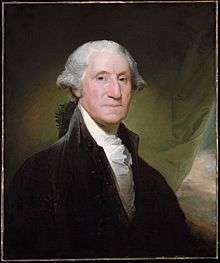
Washington was inaugurated on April 30, 1789 at age 57, taking the first presidential oath of office at Federal Hall in New York City.[257][lower-alpha 12] He arrived in a coach led by militia and a marching band, followed by statesmen and foreign dignitaries in the first inaugural parade; an estimated 10,000 people attended.[259] He stood with his hand on a Bible that was provided by the nearby Masonic lodge while the oath was administered by Chancellor Robert R. Livingston, after which he was given a 13-gun salute.[260] He then returned to the Senate Chambers where he read a 1,200–word speech, asking that an "Almighty Being" bless the "important revolution".[261] He declined a salary in his speech, but Congress later set an annual salary of $25,000 and he accepted the amount to defray costs of the presidency.[262] Washington was aware that he would set a precedent with everything that he said and did, and he attended carefully to the pomp and ceremony of office, making sure that the titles and trappings were suitably republican and did not emulate European royal courts.[263][lower-alpha 13] To that end, he preferred the title "Mr. President" over more majestic names proposed by the Senate.[264] His precedents also included messages to Congress and the cabinet form of the executive branch.[265]
New political parties emerged unexpectedly, which troubled Washington, and his two terms of office became known as the Federalist Era, when the Federalist Party dominated American politics.[266] He had planned to resign after his first term, but the unstable nation with its existing political strife convinced him that he should remain in office.[267] He was an able administrator and judge of talent and character and established many precedents; he talked regularly with department heads and listened to their advice before making a final decision.[268] He established a tolerance of opposing views, despite fears that a democratic system would lead to political violence, and he conducted a smooth transition of power to his successor.[269]
During his first term in office, Washington had to contend with major problems. The old Confederation had lacked the powers to handle its workload. It had weak leadership, no executive, a small bureaucracy of clerks, a large debt, worthless paper money, and no power to establish taxes.[270] The United States was not completely unified, and Washington had the task of assembling an executive department; he relied on Tobias Lear for advice selecting its officers.[271] Great Britain also refused to relinquish its forts in the American West,[270] the United States Army was minuscule, and the United States Navy had not materialized.
Cabinet and executive departments
.jpg)
Congress created executive departments during Washington's first months in office in 1789, including the State Department on July 27, the Department of War in early August, and the Treasury Department on September 2. The President also received two additional officers without departments: the Attorney General and Postmaster General. Washington appointed Richmond lawyer Edmund Randolph as Attorney General and Samuel Osgood as Postmaster General. He also appointed fellow Virginian Thomas Jefferson to be Secretary of State and Henry Knox as Secretary of War. Finally, he appointed Alexander Hamilton to head the Treasury Department.[272] Washington's cabinet eventually developed into a consultation and advisory body, although this was not mandated by the Constitution.[273]
Washington's cabinet members were known for their dissension, forming rival parties with sharply opposing views, most fiercely illustrated between Hamilton and Jefferson.[274] Washington restricted cabinet discussions to topics of his choosing, without participating in debate. He occasionally requested cabinet opinions in writing, and he expected his department heads to carry out his decisions without complaint. Hamilton played an active role advising Congress, including written reports and using influence over congressional committee leaders.[270]
Domestic issues

Washington was not aligned with a political party and opposed their formation, fearing that conflict that would undermine republicanism.[275] His closest advisors formed two factions, however, setting the framework for the future First Party System. Secretary of the Treasury Alexander Hamilton had plans to establish the national credit and to build a financially powerful nation, and he formed the basis of the Federalist Party. Secretary of State Thomas Jefferson was the founder of the Jeffersonian Republicans, and he strenuously opposed Hamilton's agenda. Washington favored Hamilton's agenda, which went into effect and became law, but Hamilton's fiscal recommendations created bitter controversy during Washington's presidency.[276]
Washington signed a proclamation on October 3, 1789 making November 26, 1789 to be the first Thanksgiving in order to encourage national unity. He said, "It is the duty of all nations to acknowledge the providence of Almighty God, to obey His will, to be grateful for His benefits, and humbly to implore His protection and favor." On his appointed Thanksgiving Day, he fasted while visiting debtors in prison, providing them with food and beer.[277]
National Bank
The establishment of public credit was primary task of the new federal government.[278] On January 14, 1790, Hamilton submitted a report to Congress on the matter. Madison, Hamilton, and Jefferson then reached the Compromise of 1790 in which Jefferson agreed to Hamilton’s debt proposals in exchange for moving the nation’s capitol to the south near Georgetown on the Potomac River.[276] This settled a deadlock in Congress, and the terms were legislated in the Funding Act and the Residence Act, both of which Washington signed into law on August 4. Congress authorized the assumption and payment of the nation’s debts, providing funding through customs duties and excise taxes.[279]
Hamilton created more controversy among Washington's Cabinet members when he advocated the establishment of the First Bank of the United States. Madison and Jefferson objected, but the bank easily passed Congress. Washington sought advice from his cabinet; Jefferson and Randolph strongly opposed the new bank constitutionally, while Hamilton believed that it was within the authority of the government's enumerated powers. Washington sided with Hamilton and signed the legislation on February 25; however, the rift widened between Hamilton and Jefferson and became openly hostile.[280]
Under Washington, the young nation experienced its first financial crisis in March 1792 when federalists under Hamilton used large loans to gain control of U.S. debt securities, causing a run on the new national bank,[281] but the markets returned to normal by mid-April.[282] Jefferson believed that Hamilton was part of the scheme, in spite of Hamilton's efforts to ameliorate, and Washington found himself caught in the middle of a feud.[283]
Jefferson–Hamilton feud

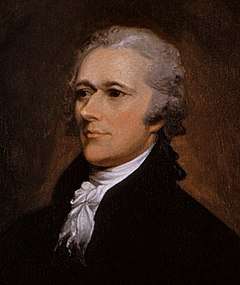
Jefferson and Hamilton staked out diametrically opposed political principles. Hamilton believed in a strong national government that needed a national bank and foreign loans to function, while Jefferson believed that the government should be primarily under the direction of the states and the farm element, and he deeply resented the idea of banks and foreign loans. This difference was the cause of continued disputes and infighting between the two, much to Washington's dismay.[284] In 1791, Jefferson and Congressman James Madison encouraged revolutionary poet Philip Freneau to form the National Gazette, a newspaper to counter the pro-Hamilton press.[285] A few weeks later, Hamilton demanded that Jefferson resign if he could not support Washington.[286] Rather than respond publicly, Jefferson told Washington that Hamilton's fiscal system would lead to the overthrow of the republic.[287]
Washington pleaded with his two secretaries by letters to stop the open warfare for the sake of the nation, but they both politely ignored the president's advice.[288] Washington reluctantly reversed his decision to retire after his first term when it became clear that this would be essential in minimizing party strife, but the feud continued after his re-election.[287] Jefferson's political actions, his support of Freneau's National Gazette,[289] and his attempt to undermine Hamilton nearly led Washington to dismiss him from the cabinet; Jefferson ultimately resigned his position in December 1793 and was thereafter forsaken by Washington.[290] The feud between Hamilton and Jefferson led to the well-defined Federalist and Republican parties, and party affiliation was necessary for election to Congress by 1794.[291]
Washington remained aloof from congressional attacks on Hamilton, but he did not write a public statement to protect him. The Hamilton–Reynolds sex scandal embarrassed Hamilton, but Washington held him in "very high esteem" and viewed him as the dominant force in establishing federal law and government.[292]
Whiskey Rebellion
In March 1791, Congress imposed an excise tax on distilled spirits to help pay the national debt; grain farmers strongly protested in frontier districts, especially the westernmost counties of Pennsylvania, saying that they were unrepresented and were unfairly shouldering too much of the debt. Threats and violence against tax collectors escalated into full-scale defiance of federal authority in 1794 known as the Whiskey Rebellion. The federal army was too small to meet the task, so Washington invoked the Militia Act of 1792 to summon militias from Pennsylvania, Virginia, Maryland, and New Jersey.[293] The governors sent the troops, with Washington taking initial command. He subsequently named Henry "Lighthorse Harry" Lee as field commander to lead the troops into the rebellious districts. The rebels dispersed and there was no fighting. Washington's forceful action demonstrated that the new government could protect itself and its tax collectors. This represented the premier instance of the federal government using military force to exert authority over the states and citizens[294] and was the only time that a sitting president personally commanded troops in the field. Washington justified his action against "certain self-created societies" whom he regarded as "subversive organizations" which threatened the national union. He was not disputing their right to protest, but insisted that their dissent should not take the form of flagrant violation of federal law. Congress overwhelmingly agreed and extended their congratulations to him, with only Madison and Jefferson expressing their indifference.[295]
Indian affairs
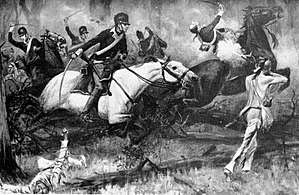
Washington's most pressing problem at the start of his presidency was the British occupation of forts in the Northwest frontier[296] and their concerted efforts to turn Indians against American settlers. The British were also protecting their interests in the Canadian fur trade, while Indian tribes warred with one other over hunting ground. Washington told Northwest Territory Governor Arthur St. Clair as early as 1789 that he preferred a peace treaty with the hostile Indians of the Ohio Country. Tribes of Indians formed a confederacy led by Little Turtle and other chiefs and were conducting numerous attacks and depredations against settlers, and they roamed largely uncontested throughout the territory. In 1790, Washington sent Brigadier General Josiah Harmar to control the situation, but he was defeated twice and forced to withdraw.[297]
The Indian Confederacy used guerrilla tactics and was an effective force against the sparsely manned American army, composed mostly of undisciplined militia, some with their families along. Washington sent St. Clair from Fort Washington on an expedition to restore peace in the territory in 1791, with the encouragement of General Knox who disliked militias. On November 4, St. Clair's forces were ambushed and overwhelmingly defeated with few survivors, despite Washington's warning of surprise attacks. Washington was outraged over the Indians' brutality and the fact that they executed captured survivors, including women and children, and Knox and others prompted him to form a new army that didn't rely on state militias.[298]
Congress vindicated St. Clair's management of the battle restore the Army's reputation, but Washington forced his resignation and replaced him with Revolutionary War hero General Anthony Wayne, who instructed his troops on Indian warfare tactics. He was determined to instill discipline in the army which was lacking under St. Clair, and he sometimes shaved, branded, or whipped soldiers to sharpen their performance;[299] three men were even executed.[300] On August 24, 1784, Wayne defeated the Northwest Indians at the Battle of Fallen Timbers, and the Ohio Country was opened up for American cession.[301] Washington equated killing Indians with killing whites, and he desired a policy to protect their property and integrate Indians into American culture.[302]
Foreign affairs
.jpg)
In April 1792, the French Revolutionary Wars broke out between Great Britain and France, and Washington declared America’s neutrality with the approval of his cabinet. The revolutionary government of France sent diplomat "Citizen Genêt" to America. He was welcomed with great enthusiasm and began promoting the case for France, using a network of new Democratic-Republican Societies in major cities. He even issued French letters of marque and reprisal to French ships manned by American sailors so that they could capture British merchant ships. Washington denounced the societies and demanded that the French recall Genêt.[303]
Hamilton formulated the Jay Treaty to normalize trade relations with Great Britain, remove them from western forts, and resolve financial debts remaining from the Revolution;[304] John Jay negotiated and signed the treaty on November 19, 1794. Jeffersonians, on the other hand, supported France and strongly attacked the treaty. Washington listened to both sides, then announced his support for the treaty, mostly because it avoided war with Britain;[305] yet he was deeply disappointed in it and claimed that its provisions were overwhelmingly on the side of Great Britain.[300] He mobilized public opinion and secured ratification in the Senate.[306] Washington was not immune to Republican criticism after he signed the Jay Treaty and was subjected to the worst and most frequent criticism that he had ever experienced.[307]
The British agreed to depart from their forts around the Great Lakes, and the United States-Canada boundary had to be modified. Numerous pre-Revolutionary debts were liquidated, and the British opened their West Indies colonies to American trade. Most importantly, the treaty secured peace with Britain and brought a decade of prosperous trade. Jefferson claimed that it angered France and "invited rather than avoided" war.[308] Relations with France deteriorated after the Jay Treaty was signed, leaving President John Adams with the prospect of war.[309] Two days before Washington's term ended, the French withdrew from their embassy in America.
Second term
Washington remained popular approaching the Election of 1792, and Hamilton urged him to run for a second term. He said nothing about this upon his return to Mount Vernon in October 1792, and many took his silence as consent and viewed him as the only viable candidate during that unstable period. The Electoral College unanimously elected him President on February 13, 1793 for a second term. John Adams was re-elected Vice President by a vote of 77 to 50.[302]
Washington was criticized by the National Gazette and political adversaries over his birthday celebration and also for appearing as a "monarchist", so he kept a low profile and arrived alone at his inauguration in a simple carriage. It was held in the Senate Chamber of Congress Hall in Philadelphia on Monday, March 4, 1793, and the presidential oath of office was administered by Associate Justice William Cushing. This was the first inauguration to take place in Philadelphia, the nation's capital at the time. Washington maintained his low profile after the ceremonies and delivered the shortest inaugural address on record.[310]
In 1793, Washington signed the Fugitive Slave Act which allowed slave owners to cross state lines and retrieve runaway slaves.[311] He also signed into law the Slave Trade Act of 1794 which limited American involvement in the Atlantic slave trade.[312] He appointed Oliver Wolcott, Jr. as Secretary of the Treasury in 1795, replacing Alexander Hamilton who resigned in the aftermath of the whiskey rebellion for which he was criticized; he also wished to return home to his wife who suffered a miscarriage in his absence. The affair strengthened Washington's bond with Hamilton, while it distanced him from Knox.[313]
Washington was relentlessly assailed by his political foes and a largely partisan press in the final months of his presidency, and they accused him of being ambitious and greedy. He pointed out that he had taken no salary during the entire war and risked his life in numerous battles, and he regarded the press as an erosive and disuniting force which spread numerous falsehoods, referring to them as "diabolical". This also had a great influence in his Farewell Address, which expressed how troubled he was by the years of in-fighting and character assassination by much of the press.[314]
Washington wanted to retire when his first term ended but all his advisors begged him to stand for reelection. By 1796 he insisted on retiring, for both personal and political reasons. He felt worn out, and was disgusted with the virulent personal attacks on his integrity. Politically he felt America needed a contested presidential election with a choice of candidates, which would not happen if he ran again. If he won and then died a vice president would take over who was not elected and his goal would fail. (He in fact did die in 1799 two years into the new term). The election went forward and he was absolutely neutral between Adams and Jefferson. He personally did not feel bound by a two-term limit, but he relinquished power, once again giving impetus to this idea. However, Washington has been misinterpreted as the founder of a two-term presidential limit, but proper attribution for this custom belonged to Thomas Jefferson, who refused to run for a third term on political foundation. In the 1780s, about half the states provided term limits for governors.[315][316]
Farewell Address
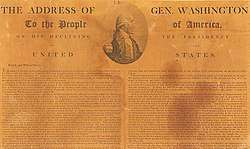
Washington had planned to retire after his first term as President, and he had James Madison draft a farewell message in 1792, the sentiment and theme being Washington's; he then put it in a drawer of his presidential desk when he was re-elected.[317] He gave the draft to Hamilton to complete on May 15, 1796, with additional text that he had written himself.[318] The final version of the Farewell Address was published on September 19, 1796 by David Claypool's American Daily Advertiser, and then published by three other Philadelphia newspapers.[319] It warned against foreign alliances and their influence in domestic affairs, and against bitter partisanship in domestic politics. It also called for men to move beyond partisanship and serve the common good, [320] stressing that the United States must concentrate on its own interests. He counseled friendship and commerce with all nations, but advised against involvement in European wars.[321] He stressed the importance of religion, claiming that "religion and morality are indispensable supports" in a republic.[322] The address, however, did not quell bipartisan politics but served to aggravate them, setting the tone for the coming 1796 election when Washington supported John Adams.[320]
On December 7, 1796 Washington read his Eighth Annual Address to Congress. He spoke before the House, wore a black velvet suit, and donned his sword, while he was well received by "the largest assemblage of citizens" in the crowded gallery.[323] He advocated for the creation of a military academy, and expounded on the fact that the British had vacated the Northwest Forts and Algiers had released American prisoners. The speech was well received. [324]
Washington's Farewell Address proved to be one of the most influential statements on republicanism.[325] It stressed the necessity and importance of national union, the value of the Constitution, the rule of law, the evils of political parties, and the proper virtues of a republican people. He refers to morality as "a necessary spring of popular government". "Whatever may be conceded to the influence of refined education on minds of peculiar structure, reason, and experience, both forbid us to expect that national morality can prevail in exclusion of religious principle."[326]
Slavery

Junius Brutus Stearns, 1851
Washington was born into a world accustomed to slavery; he had no qualms about it prior to 1775 and held traditional views that blacks were an inferior race. During the war, however, his views moderated under the influence of anti-slavery aides and officers.[327] He spoke often of ending slavery following the war, but he never voiced those views publicly, fearing that the issue would divide the new nation.[328]
There are conflicting reports of slave treatment at Mount Vernon. Washington discouraged cruelty, yet there are records of harsh punishments which included whippings being inflicted on male and female slaves by their overseers–some of whom were also slaves. In some cases, runaway slaves were put in shackles.[329] When he was President, Washington maintained distant supervision of Mount Vernon through letters to his overseers,[330] though there is only one account from him authorizing a whipping that was given to a slave for badly beating his wife.[331] He directed that a warning be given to first offenders before resorting to whipping, which was then subject to his prior approval; this wasn't always enforced due to his prolonged absences.[332] In severe circumstances, he shipped unruly slaves to the West Indies. He also used non-violent forms of discipline, including cash payments, material incentives, and what he referred to as "admonition and advise".[333]
Washington sometimes personally cared for ill or injured slaves, and he provided physicians and mid-wives. By the Revolutionary War, he had all his slaves inoculated for smallpox. He ordered them to work from dawn to dusk,[334] and they were often poorly clothed and housed—yet they were well fed and received two hours off for meals during the workday. They worked shorter days in the winter months and were given time off on Sundays, Christmas, Easter, and Pentecost.[335][336]
During the war, Washington initially forbade blacks from becoming soldiers, but he allowed them to serve in the Continental Army beginning in January, 1776 in order to counter Loyalist Governor Dunmore's offer to free slaves if they fought for the British. After the war, Washington ceased his slave-trading and supported many slaves who were too young or too old to work, greatly increasing Mount Vernon's slave population and causing the plantation to operate at a loss.[337] His manager noticed that there were more than 300 slaves at Mount Vernon, but only 100 were needed for profitable operation.[338] By 1799, there were 317 slaves living at Mount Vernon; he owned 124 outright and held 153 for his wife’s dower interest.[103] At times, Mount Vernon slaves ran away to find freedom, encouraged by Quaker abolitionists.[103][339] Washington used secretive methods to return them rather than post public advertisements in the North.[340] For example, he privately ordered the capture of his wife's fugitive slave Oney Judge in 1796.[339]
During the summer of 1799, he resolved his personal struggle with slave-holding by making a new will which directed that his 124 slaves be freed upon the death of Martha;[341] he was among the few slave-holding Founding Fathers to do so.[342] He provided that old and young freed people be taken care of indefinitely; younger ones were to be taught to read and write and placed in suitable occupations. Martha freed his slaves on January 1, 1801. Historian John Ferling posits that Washington's will and the freeing of his slaves were "an act of atonement for a lifetime of concurrence in human exploitation."[341]
Retirement (1797–1799)
Washington retired from the presidency in March 1797 and returned to Mount Vernon with a profound sense of relief. He devoted much time to his plantations and other business interests, including his distillery which produced its first batch of spirits in February 1797.[343] His plantation operations were only minimally profitable.[344] His lands in the west (Piedmont) yielded little income because they were under attack by Indians, and the squatters living there refused to pay him rent. He attempted to sell off these holdings but failed to obtain the price that he desired.[345] Once in retirement, he became an even more committed Federalist. He was vocal in his support of the Alien and Sedition Acts and convinced Federalist John Marshall to run for Congress to weaken the Jeffersonian hold on Virginia.[346]
Washington grew restless of retirement, prompted by tensions with France, and he wrote to Secretary of War James McHenry offering to organize President Adams' army.[347] French privateers began seizing American ships in 1798, and relations with France deteriorated and led to the Quasi-War. Adams offered Washington a commission as lieutenant general on July 4, 1798, and as Commander-in-chief of the armies raised for service in that conflict. He accepted and served as the Commanding General from July 13, 1798 until his death 17 months later. He participated in planning for a provisional army to meet any emergency, but he avoided involvement in details. He delegated most of the work to Hamilton, including active leadership of the army as a major general. No army invaded the United States during this period, and Washington did not assume a field command.[348][lower-alpha 14]
It is popularly assumed that Washington was rich because of the well-known "glorified façade of wealth and grandeur" at Mount Vernon,[349] but nearly all of his wealth was tied up in land and slaves. Historians estimate that this estate was worth about $1 million in 1799 dollars, equivalent to about $19.9 million in 2014.[350]
Final days
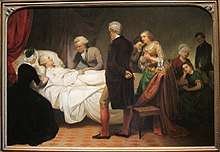
Junius Brutus Stearns 1799
On Thursday, December 12, 1799, Washington inspected his farms by horse while snow and sleet were falling. He returned late for dinner, his neck was wet, and snow matted his hair. He refused to change his wet clothes, not wanting to keep his guests waiting. He had a sore throat the following day but again went out in freezing, snowy weather to mark trees for cutting. That evening, he complained of a sore throat and chest congestion, but he remained cheerful. On Saturday morning, he awoke to an inflamed throat and difficulty breathing. He ordered estate overseer George Rawlins to remove nearly a pint of his blood, a common practice of the time, and several physicians[lower-alpha 15] were summoned.[352][353]
Dr. Brown thought that Washington had "quinsey" or "quincy", while Dick thought that the condition was a more serious "violent inflammation of the throat".[354] Continued blood-letting (approximately five pints) proved unsuccessful. Dick proposed an emergency tracheotomy, but the other two doctors were unfamiliar with the new procedure and disapproved, so it was not used.[355] Washington instructed Brown and Dick to stop their attempts to save his life and leave the room, while he assured Craik, "Doctor, I die hard, but I am not afraid to go".[356]
Washington's illness and death came swiftly and unexpectedly.[357] He died peacefully with Martha calmly composed at the foot of his bed around 10 p.m. on Saturday, December 14, 1799 at age 67. His personal secretary Tobias Lear recorded his last words as "'Tis well." Funeral arrangements were made by Washington's Masonic lodge of Alexandria, Virginia. When news of his death reached Congress, they immediately adjourned for the day and the Speaker's chair was shrouded in black the next morning.[358]
The funeral was held on December 18, 1799 at Mount Vernon, where his body was interred. Cavalry and foot soldiers led the procession, while six colonels served as the pallbearers. The Mount Vernon funeral service was restricted mostly to family and friends. Congress chose Henry Lee III to deliver the eulogy, a Continental Army officer and loved by Washington. Word of his death traveled slowly; church bells rang in the cities, and many places of business closed.[359] People worldwide admired Washington and were saddened by his death, and memorial processions were held in major cities of the United States. Martha wore a black mourning cape for one year, and she burned their correspondence to protect their privacy. Only five letters between the couple are known to have survived, two letters from Martha to George and three from him to her.[360]
Subsequent diagnoses
The diagnosis of Washington's illness and the immediate cause of his death have been subjects of debate since the day that he died. In the days immediately following his death, Craik and Brown's published account[lower-alpha 16] stated that his symptoms had been consistent with cynanche trachealis, a term of that period used to describe severe inflammation of the structures of the upper airway. Accusations have persisted since Washington's death concerning medical malpractice, with some believing that he had been bled to death.[355] Various modern medical authors have speculated that he died from a severe case of epiglottitis complicated by the given treatments (which were all accepted medical practice in that day), most notably the massive deliberate blood loss which almost certainly caused hypovolemic shock.[lower-alpha 17]
Burial
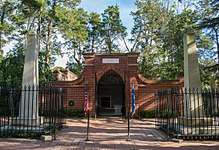
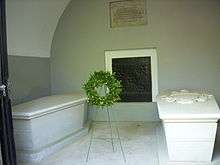
Washington was buried in the old family vault at Mount Vernon, situated on a grassy slope covered with juniper and cypress trees. It contained the remains of his brother Lawrence and other family members, but the decrepit vault was in need of repair, prompting Washington to leave instructions in his will for the construction of a new vault.[359]
In 1830, a disgruntled ex-employee of the estate attempted to steal Washington's skull.[365] The next year, the new vault was constructed at Mount Vernon to receive the remains of George and Martha and other relatives.[366] In 1832, a joint Congressional committee debated moving his body from Mount Vernon to a crypt in the Capitol. The crypt had been built by architect Charles Bulfinch in the 1820s during the reconstruction of the burned-out capital, after the Burning of Washington by the British during the War of 1812. Southern opposition was intense, antagonized by an ever-growing rift between North and South; many were concerned that Washington's remains could end up on "a shore foreign to his native soil" should the country become divided.[367]
On October 7, 1837, Washington's remains were placed, still in the original lead coffin, within a marble sarcophagus designed by William Strickland and constructed by John Struthers earlier that year.[368][369] The sarcophagus was sealed and encased with planks, while an outer vault was constructed around it.[368] The outer vault has the sarcophagi of George and Martha Washington; the inner vault has the remains of other Washington family members and relatives.[366]
Historical reputation and legacy

Washington's legacy endures as one of the most influential in American history, since he served as Commander-in-Chief of the Continental Army, a hero of the Revolution, and the first President of the United States.[lower-alpha 18] Congressman Henry "Light-Horse Harry" Lee was a Revolutionary War comrade, and he famously eulogized Washington: "First in war—first in peace—and first in the hearts of his countrymen".[370] Lee's words became the hallmark by which Washington's overwhelming reputation was impressed upon the American memory, with biographers hailing him as the great exemplar of republicanism. He set many precedents for the national government and the presidency in particular, and he was called the "Father of His Country" as early as 1778.[371][lower-alpha 19] Congress proclaimed Washington's birthday to be a federal holiday.[373] Biographer Douglas Southall Freeman concludes, "The great big thing stamped across that man is character." By character, says David Hackett Fischer, "Freeman meant integrity, self-discipline, courage, absolute honesty, resolve, and decision, but also forbearance, decency, and respect for others." [374]
Washington became an international icon for liberation and nationalism, as the leader of the first successful revolution against a colonial empire. The Federalists made him the symbol of their party, but the Jeffersonians continued to distrust his influence for many years and delayed building the Washington Monument.[375] On January 31, 1781, he was elected a member of the American Academy of Arts and Sciences.[376]
During the United States Bicentennial, Washington was posthumously appointed to the grade of General of the Armies of the United States by the congressional joint resolution Public Law 94-479 passed on January 19, 1976, with an effective appointment date of July 4, 1976.[241] This restored his place as the highest-ranking military officer in U.S. history.[lower-alpha 20]
The most popular childhood story about Washington is that he chopped down his father's favorite cherry tree and admitted the deed when questioned: "I cannot tell a lie".[378] The anecdote was first reported by biographer Parson Weems, based on the memories of people who knew him as a child.[379] However, Weems never asserted that the tree was actually chopped down, but that the young Washington instead had merely removed some of the tree bark with his hatchet.[lower-alpha 21] Weems' account of the incident has never been proven or disproven.[381]
Monuments and memorials

Many places and monuments have been named in honor of Washington, most notably the nation's capital. The state of Washington is the only state to be named after a president.[382] The George Washington Bridge is named in his honor, as are several naval vessels, including the nuclear-powered aircraft carrier USS George Washington (CVN-73).[383]
Washington, Theodore Roosevelt, Thomas Jefferson, and Abraham Lincoln are depicted in stone at the Mount Rushmore Memorial. The Washington Monument was built in his honor and the George Washington Masonic National Memorial in Alexandria, Virginia was constructed between 1922 and 1932 with contributions from the Freemasons.[384]
After Washington's death, Congress authorized a memorial in the national capital, but the decision was reversed when the Democratic-Republicans took control of Congress in 1801. The Democratic-Republicans were dismayed that Washington had become the symbol of the Federalist Party.[385] Construction of the 555-foot (169 m) memorial was further delayed by politics and funding problems; it did not begin until 1848 and was not completed until 1885
Statues and sculptures
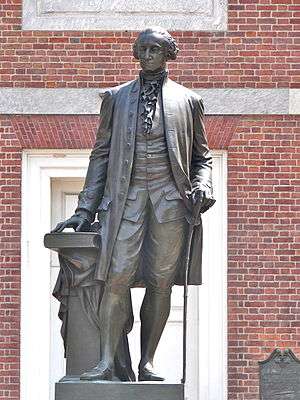
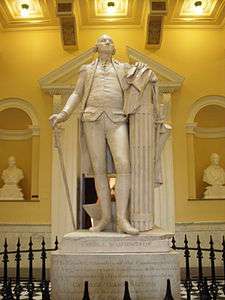 Jean-Antoine Houdon's statue, State Capitol in Virginia
Jean-Antoine Houdon's statue, State Capitol in Virginia- Lieutenant General George Washington, Washington Circle, Washington, D.C.
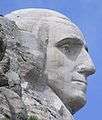 Mt. Rushmore, George Washington closeup
Mt. Rushmore, George Washington closeup
Postage and Currency
George Washington appears on contemporary U.S. currency, including the one-dollar bill and the quarter-dollar coin (the Washington quarter). Washington and Benjamin Franklin appeared on the nation's first postage stamps in 1847. Since that time, Washington has appeared on many postage issues, more than all other presidents combined.[386]
Selected issues
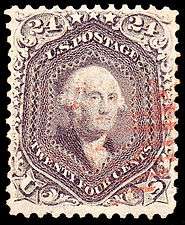 Washington issue of 1862 |
.jpg) Washington-Franklin issue of 1917 |
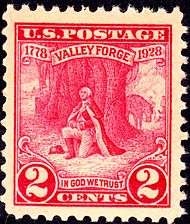 Washington at Valley Forge issue of 1928 |
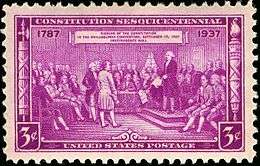 Washington as President of the Constitutional Convention issue of 1937 |
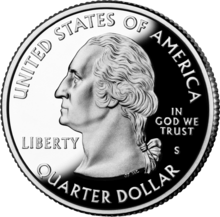 Washington quarter dollar |
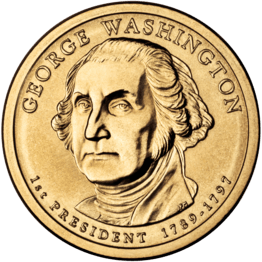 Washington one dollar coin |
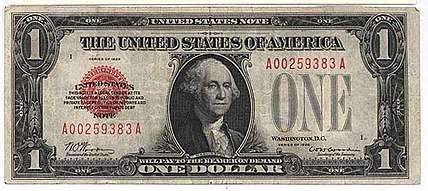 Washington on the 1928 dollar bill |
Papers
The serious collection and publication of Washington's documentary record began with the pioneer work of Jared Sparks in the 1830s in Life and Writings of George Washington (12 vols., 1834–1837).[387] The Writings of George Washington from the Original Manuscript Sources, 1745–1799 (1931–44) is a 39-volume set edited by John Clement Fitzpatrick who was commissioned by the George Washington Bicentennial Commission. It contains over 17,000 letters and documents and is available online from the University of Virginia.[388] The definitive letterpress edition of his writings was begun by the University of Virginia in 1968, and today comprises 52 published volumes with more to come. It contains everything written by Washington or signed by him, together with most of his incoming letters. Part of the collection is available online from the University of Virginia.[389]
Washington's personal annotated copy of the "Acts Passed at a Congress of the United States of America" from 1789 includes the Constitution of the United States and a draft of the Bill of Rights. It was sold at Christie's to The Mount Vernon Ladies' Association on June 22, 2012 for $9,826,500 (plus fees). This was the record for a document sold at auction.[390]
Portraits gallery
See also: Gallery of Washington portraits
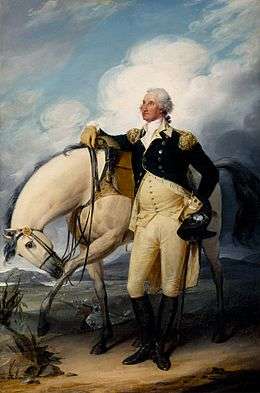
 George Washington
George Washington
by Giuseppe Perovani,
1796

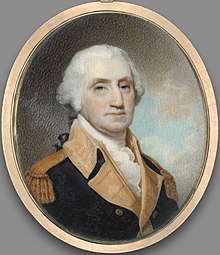

See also
- Electoral history of George Washington
- Culper Ring, the spy ring organized by Benjamin Tallmadge and supervised by Washington
- British Army during the American War of Independence
- Conotocaurious (Town Destroyer), a nickname given to Washington by Iroquois Native Americans
Notes
- ↑ March 4 is the official start of the first presidential term. April 6 is when Congress counted the votes of the Electoral College and certified a president. April 30 is when Washington was sworn in.
- ↑ Old style: February 11, 1731
- ↑ Contemporaneous records used the Julian calendar and the Annunciation Style of enumerating years, recording his birth as February 11, 1731. The provisions of the British Calendar (New Style) Act 1750, implemented in 1752, altered the official British dating method to the Gregorian calendar with the start of the year on January 1 (it had been March 25). These changes resulted in dates being moved forward 11 days, and an advance of one year for those between January 1 and March 25. For a further explanation, see Old Style and New Style dates.[2]
- ↑ Three siblings died before adulthood: sister Mildred at age one, half-brother Butler in infancy, and half-sister Jane at age 12.[8]
- ↑ Ellis and Ferling, for example, point to his negative experiences dealing with the Continental Congress during the Revolution, and Don Higginbotham places Washington's first formal advocacy of a strong central government in 1783.[75]
- ↑ Washington secretly instructed Captain William Crawford of the Ohio Country to scout out forbidden lands in the 1760s, beyond the Kings' Royal Proclamation Line.[122]
- ↑ In a letter of September 20, 1765, Washington protested to Robert Cary & Co. of the low prices that he received for his tobacco, and for the inflated prices that he was forced to pay on second-rate goods from London.[124]
- ↑ Congress initially attempted to direct the war effort in June, 1776 with the committee known as "Board of War and Ordnance"; this was succeeded by the Board of War in July 1777, which eventually included members of the military.[148]
- ↑ This painting has received both acclaim and criticism;[162] see Emanuel Leutze article for details.
- ↑ Durham Boats were built for the Durham Iron Works to carry iron ore, lumber, or grain on the upper Delaware.[168]
- ↑ Starting in 1774, 14 men served as President of the Continental Congress but bore no relationship to the presidency established under Article II of the Constitution. Under the Articles of Confederation, Congress called its presiding officer "President of the United States in Congress Assembled", but this position had no national executive powers.[250][251]
- ↑ There has been debate and controversy over whether Washington added "so help me God" to the end of the oath.[258]
- ↑ Washington wrote to James Madison: "As the first of everything in our situation will serve to establish a precedent, it is devoutly wished on my part that these precedents be fixed on true principles." Washington to James Madison, May 5, 1789, cited by Unger, 2013, p. 76.
- ↑ He was the only former President who served as a presidential appointee until 1921, when President Warren G. Harding appointed former President William Howard Taft as Chief Justice of the United States.
- ↑ Doctors James Craik, Gustavus Richard Brown, and Elisha C. Dick. (Dr. William Thornton arrived some hours after Washington died.[351])
- ↑ The first account of Washington's death was written by Doctors Craik and Brown, published in The Times of Alexandria five days after his death on December 19, 1799. It can be found in The Eclectic Medical Journal (1858)[361]
- ↑ Modern experts have concluded that Washington probably died from acute bacterial epiglottitis complicated by the administered treatments, including Morens and Wallenborn in 1999,[362][353] Cheatham in 2008, [363] and Vadakan in 2005[364]. These treatments included multiple doses of calomel (a cathartic or purgative) and extensive bloodletting.
- ↑ Historians Jay A. Parry and Andrew M. Allison declare that Washington "was the dominant personality in three of the most critical events in that founding: the Revolutionary War, the Constitutional Convention, and the first national administration. Had he not served as America's leader in those three events, all three likely would have failed. And America as we know it today would not exist." Parry, 1991, p. xi.
- ↑ The earliest known image in which Washington is identified as the Father of His Country is in the frontispiece of a 1779 German-language almanac, with calculations by David Rittenhouse and published by Francis Bailey in Lancaster County Pennsylvania. Der Gantz Neue Verbesserte Nord-Americanische Calendar has Fame appearing with an image of Washington holding a trumpet to her lips, from which come the words "Der Landes Vater" (translated as "the father of the country" or "the father of the land").[372]
- ↑ In Portraits & Biographical Sketches of the United States Army's Senior Officer,[377] William Gardner Bell states that Washington was recalled back into military service from his retirement in 1798, and "Congress passed legislation that would have made him General of the Armies of the United States, but his services were not required in the field and the appointment was not made until the Bicentennial in 1976, when it was bestowed posthumously as a commemorative honor." How many U.S. Army five-star generals have there been and who were they? states that President Ford specified that Washington would "rank first among all officers of the Army, past and present."
- ↑ Weems' story was published in 1806 and reads: "One day, in the garden, where he often amused himself hacking his mother's pea-sticks, he unluckily tried the edge of his hatchet on the body of a beautiful young English cherry-tree, which he barked so terribly, that I don't believe the tree ever got the better of it.[380]
References
- ↑ Ferling 2009, p. 44.
- ↑ Engber 2006.
- ↑ Ferling 2002, p. 3; Chernow 2010, pp. 5–7.
- ↑ Chernow 2010, p. 3-5.
- ↑ Chernow 2010, pp. 6–7; Alden 1993, pp. 2, 26; Randall 1997, p. 17.
- ↑ Cooke 2002, p. 2; Hofstra 1998, p. vii; Alden 1993, pp. 3–4; Wiencek 2003, p. 54.
- ↑ Ferling 2002, p. 3.
- ↑ Fitzpatrick 1936, pp. V19: 509–510; Chernow 2010, pp. 6–8.
- ↑ Ferling 2002, p. 4; Chernow 2010, pp. 7–8.
- ↑ Chernow 2010, pp. 8–10.
- ↑ Chernow 2010, p. 10.
- ↑ Ferling 2002, p. 14; Chernow 2010, pp. 11–12.
- ↑ Knott 2005, pp. 1–5; Ferling 2010, pp. 5–6; Ferling 2002, p. 14; Chernow 2010, pp. 11–12.
- ↑ Chernow 2010, pp. 11–12.
- 1 2 3 Fitzpatrick 1936, p. V19: 510.
- ↑ Chernow 2010, p. 12.
- ↑ Freeman 1948, p. 1:199; Chernow 2010, pp. 16–18.
- ↑ Cooke 2002, p. 2; Chernow 2010, p. 10.
- ↑ Cooke 2002, p. 2; Alden 1993, pp. 4–5, 73; Chernow 2010, pp. 10–14, pp=15–16.
- ↑ Randall 1997, p. 36.
- 1 2 Chernow 2010, p. 444.
- ↑ Fitzpatrick 1936, p. V19: 510; Chernow 2010, p. 19.
- ↑ Fitzpatrick 1936, p. V19: 510; Chernow 2010, p. 22.
- ↑ Randall 1997, pp. 54–55; Chernow 2010, pp. 22–23.
- ↑ Chernow 2010, p. 23.
- ↑ "George Washington's Aggressive Real Estate Investment".
- ↑ Chernow 2010, pp. 704–705.
- ↑ Chernow 2010, p. 24.
- ↑ Flexner 1974, p. 8.
- ↑ Freeman 1948, p. 1:264; Chernow 2010, p. 26.
- ↑ Freeman 1948, pp. 1:15–72; Chernow 2010, p. 26.
- ↑ Ferling 2002, p. 16; Randall 1997, pp. 34, 436; Chernow 2010, pp. 29–30.
- ↑ Ferling 2002.
- ↑ Ferling 2002, p. 16; Chernow 2010, pp. 29–30.
- ↑ Chernow 2010, p. 123-125.
- ↑ Chernow 2010, p. 30.
- ↑ Chernow 2010, pp. 30, 290, 437–439, 642–643.
- ↑ Chernow 2010, pp. 642–643.
- ↑ Chernow 2010, pp. 124, 469.
- ↑ Chernow 2010, p. 124.
- ↑ Chernow 2010, p. 469.
- ↑ Chernow 2010, p. 134.
- ↑ Freeman 1948, p. 1:268; Fitzpatrick 1936, p. 510.
- ↑ Chernow 2010, pp. 26–27, 31; Randall 1997, p. 74.
- ↑ Freeman 1948, pp. 1:274–327; Chernow 2010, p. 33.
- ↑ Lengel 2005, pp. 23–24; Fitzpatrick 1936, pp. 510–511, v. 19; Chernow 2010, p. 33.
- 1 2 Fitzpatrick 1936, p. 511, v. 19.
- ↑ Grizzard 2002, p. 86; Lengel 2005, p. xxiii.
- 1 2 "Ten Facts About George Washington and the French & Indian War".
- ↑ Alden 1993, p. 13.
- ↑ Lengel 2005, pp. 31–38; Anderson 2000, pp. 53–58; Misencik 2014, p. 131.
- 1 2 Fitzpatrick 1936, p. V19: 511.
- ↑ Grizzard 2002, pp. 115–19; Lengel 2005, p. 44.
- 1 2 Ellis 2004, pp. 17–18.
- ↑ Ferling 2009, pp. 25–27.
- ↑ Anderson 2005, pp. 100–01.
- 1 2 3 Fitzpatrick 1936, p. 511.
- ↑ Alden 1993, pp. 35–36.
- 1 2 Alden 1993, p. 37; Ferling 2010, pp. 35–36.
- 1 2 Alden 1993, pp. 37–46.
- ↑ Ferling 2009, pp. 28–30.
- 1 2 Fitzpatrick 1936, pp. 511–512.
- ↑ Fitzpatrick 1936, pp. 511–512; Flexner 1965, p. 138; Fischer 2004, pp. 15–16; Ellis 2004, p. 38.
- 1 2 Chernow 2010, pp. 72–73.
- ↑ Fischer 2004, pp. 15–16; Ellis 2004, p. 38.
- 1 2 3 Fitzpatrick 1936, p. 512.
- ↑ Fitzpatrick 1936, p. 512; Chernow 2010, p. 87.
- ↑ Fitzpatrick 1936, p. 87; Chernow 2010, p. 512.
- ↑ Chernow 2010, p. 90.
- ↑ Ferling 2009, pp. 41–42; Chernow 2010, pp. 90–91.
- ↑ Lengel 2005, pp. 75–76, 81.
- ↑ Chernow 2010, pp. 91–93; Lengel 2005, p. 80.
- ↑ Chernow 2010, pp. 92–93.
- ↑ Ellis 2004, p. 218; Ferling 2009, pp. 32–33, 200, 258–272, 316.
- ↑ Higginbotham 2002, p. 37.
- ↑ Higginbotham 1985, pp. 22–25.
- ↑ Freeman 1968, pp. 136–37.
- 1 2 Tsakiridis 2018.
- ↑ Chernow 2010, p. 6; Morrison 2009, p. 136; Alden 1993, p. 2, 26; Randall 1997, p. 17; Tsakiridis 2018.
- ↑ Chernow 2010, p. 130; Thompson 2008, p. 40; Tsakiridis 2018.
- ↑ Frazer 2012, pp. 198–199; Chernow 2010, p. 119, 132; Tsakiridis 2018.
- ↑ Chernow 2010, pp. 131, 470; Johnson 1919, pp. 87–195; Espinosa 2009, p. 52; Frazer 2012, pp. 201–203; Tsakiridis 2018.
- ↑ Randall 1997, p. 67; Tsakiridis 2018.
- ↑ Chernow 2010, p. 131; Tsakiridis 2018.
- ↑ Chernow 2010, pp. 131–132.
- ↑ Novak 2007, p. 95; Tsakiridis 2018.
- ↑ Chernow 2010, pp. 131–132; Morrison 2009, p. 136; Tsakiridis 2018.
- ↑ Frazer 2012, pp. 197–198, 201–203; Novak 2007, pp. 158–161.
- ↑ Novak 2007, p. 122.
- ↑ Boller 1963, p. 125.
- ↑ Chernow 2010, p. 131.
- 1 2 Wood 2001, p. 313.
- ↑ Lillback & Newcombe 2006, p. 313–314.
- ↑ Chernow 2010, pp. 132, 500; Morrison 2009, p. 136; Stavish 2007, pp. XIX, XXI; Immekus 2018.
- ↑ Chernow 2010, pp. 27, 704.
- ↑ Randall 1997, p. 67; Chernow 2010, p. 27.
- 1 2 Immekus 2018.
- ↑ "A Brief History" (GWMNMA).
- ↑ Ferling 2002, pp. 33–34; Wiencek 2003, p. 69.
- ↑ Chernow 2010, p. 103; Flexner 1974, pp. 42–43; Bumgarner 1994, pp. 1–8.
- ↑ Chernow 2010, pp. 97–98; Fischer 2004, p. 14.
- ↑ Wiencek 2003, pp. 67–69, 336.
- 1 2 3 "Ten Facts About Washington & Slavery".
- ↑ Rasmussen & Tilton 1999, p. 100.
- ↑ Chernow 2010, p. 184.
- ↑ Grizzard 2002, pp. 135–37.
- 1 2 Ellis 2004, pp. 41–42, 48.
- ↑ Alden 1993, p. 71.
- ↑ Ferling 2009, pp. 49–54, 68.
- ↑ Ferling 2002, pp. 43–44; Ellis 2004, p. 44.
- ↑ Ellis 2004, pp. 49–50.
- ↑ Pogue 2004, pp. 2–10.
- ↑ Hirschfeld 1997, pp. 44–45; Ferling 2009, p. 351.
- ↑ Ferling 2002, pp. 44–45.
- ↑ Chernow 2010, p. 161.
- ↑ Higginbotham 2001, p. 154.
- ↑ Ferling 2010, pp. 66–67; Ellis 2004, pp. 50–53; Higginbotham 2001, pp. 67–93.
- ↑ Fischer 2004, p. 14.
- ↑ Ferling 2002, pp. 73–76.
- ↑ Chernow 2010, p. 136.
- ↑ Chernow 2010, p. 137; Taylor 2016, p. 61.
- ↑ Chernow 2010, p. 148.
- ↑ Ferling 2009, p. 68.
- ↑ Chernow 2010, p. 138.
- ↑ Taylor 2016, p. 103.
- ↑ Freeman 1968, pp. 174–76; Taylor 2016, p. 75.
- ↑ Randall 1997, p. 262; Chernow 2010, p. 166.
- ↑ Alden 1993, p. 101.
- ↑ Chernow 2010, p. 167.
- ↑ Ferling 2010, p. 100; Ford, Hunt & Fitzpatrick 1904, p. V19: 11.
- ↑ Taylor 2016, p. 160–161.
- ↑ Taylor 2016, pp. 132–133.
- ↑ Ellis 2004, pp. 67–68; Chernow 2010, p. 185–186; Fitzpatrick 1936, p. 514.
- ↑ Rasmussen & Tilton 1999, p. 294; Fitzpatrick 1936, p. 514; Taylor 2016, pp. 141–142.
- ↑ Ferling 2009, pp. 86–87; Fitzpatrick 1936, p. 514.
- ↑ Chernow 2010, pp. 190–191; Ferling 2002, p. 108.
- ↑ Ferling 2002, pp. 109–110.
- ↑ Taylor 2016, p. 143.
- ↑ Ferling 2002, p. 112; Taylor 2016, p. 143; Fitzpatrick 1936, p. 514.
- ↑ Ferling 2002, pp. 112–113.
- ↑ Ferling 2002, p. 116.
- 1 2 Taylor 2016, p. 144.
- ↑ Taylor 2016, pp. 151–152.
- ↑ Taylor 2016, p. 153.
- 1 2 Ferling 2002, p. 117.
- ↑ Ferling 2002, pp. 117–118.
- ↑ Ferling 2002, pp. 116–117.
- 1 2 Freedman 2008, p. 42.
- ↑ Lengel 2005, pp. 124–126; Higginbotham 1985, pp. 125–34; Ferling 2002, p. 118–119; Taylor 2016, pp. 153–154; Fitzpatrick 1936, p. 514.
- ↑ Fitzpatrick 1936, pp. 514–515.
- ↑ Taylor 2016, pp. 162–163.
- ↑ Chernow 2010, pp. 244–245; Taylor 2016, pp. 162–163.
- ↑ Ellis 2004, pp. 95–96.
- ↑ Chernow 2010, p. 244.
- ↑ Taylor 2016, p. 164.
- ↑ McCullough 2005, pp. 186–95.
- ↑ Chernow 2010, p. 240; Davis 1975, pp. 93–94; Taylor 2016, p. 164.
- ↑ Taylor 2016, p. 165.
- ↑ Davis 1975, p. 136; Chernow 2010, p. 257.
- ↑ Alden 1993, p. 137; Taylor 2016, p. 165.
- ↑ Taylor 2016, pp. 166–167.
- ↑ Howat 1968, pp. 290, 293, 297; Nowlan 2012, p. 66.
- ↑ Taylor 2016, p. 166.
- ↑ Fischer 2004, pp. 224–226; Taylor 2016, p. 169.
- ↑ Taylor 2016, pp. 166–167, 169.
- ↑ Ketchum 1999, p. 235; Chernow 2010, p. 264.
- ↑ Taylor 2016, p. 169.
- ↑ Fischer 2004, p. 216.
- ↑ Chernow 2010, pp. 270–272; Randall 1997, p. 319.
- ↑ Fischer 2004, pp. 215–217.
- ↑ Fischer 2004, pp. 215–219.
- ↑ Fischer 2004, pp. 228–230.
- ↑ Fischer 2004, pp. 232–234, 405.
- ↑ Chernow 2010, p. 276.
- ↑ Ketchum 1999, pp. 306–307; Alden 1993, p. 146.
- ↑ Alden 1993, p. 145.
- ↑ Ketchum 1999, p. 361–364; Fischer 2004, p. 339; Chernow 2010, pp. 276–278.
- 1 2 3 Taylor 2016, p. 172.
- ↑ Chernow 2010, pp. 285–286.
- ↑ Fischer 2004, p. 367.
- ↑ Fischer 2004, p. 151.
- ↑ Ferling 2007, p. 188.
- ↑ Henderson 2009, p. 47.
- ↑ Randall 1997, pp. 340–341.
- ↑ Heydt 2005, pp. 50–73.
- ↑ Chernow 2010, p. 312–314; Higginbotham 1971.
- ↑ Chernow 2010, pp. 312–313.
- ↑ Alden 1993, p. 163.
- ↑ Ferling 2002, pp. 186; Alden 1993, pp. 165, 167; Freedman 2008, p. 30.
- ↑ Alden 1993, p. 165.
- ↑ Randall 1997, pp. 342, 359; Ferling 2009, p. 172.
- ↑ Alden 1993, p. 168; Randall 1997, pp. 342, 356.
- ↑ Chernow 2010, p. 336.
- ↑ Taylor 2016, p. 188.
- ↑ Alden 1993, pp. 176–77; Ferling 2002, pp. 195–97.
- ↑ Chernow 2010, p. 344.
- 1 2 3 Taylor 2016, p. 230.
- 1 2 Taylor 2016, p. 234.
- ↑ Taylor 2016, pp. 234–235.
- ↑ Alden 1993, pp. 187–188.
- ↑ Grizzard 2002, p. 303.
- ↑ Alden 1993, p. 184.
- ↑ Chernow 2010, p. 360.
- ↑ Mann 2008, p. 106.
- ↑ Nagy 2016, p. 274.
- ↑ Rose 2006, p. 75, 224, 258–61.
- ↑ Chernow 2010, pp. 378–387; Ward 1994.
- ↑ Adams 1928, p. 365; Philbrick 2016, p. 243; Palmer 2010, p. 304; Taylor 2016, pp. 204–206.
- ↑ Palmer 2010, p. 203; Flexner 1991, pp. 119–221; Rose 2006, p. 196; Taylor 2016, p. 206.
- ↑ Adams 1928, p. 365; Palmer 2010, pp. 306, 315, 319, 320.
- ↑ Adams 1928, pp. 365–366; Philbrick 2016, pp. 250–251; Ward 1994.
- ↑ Chernow 2010, pp. 378, 380–381; Lengel 2005, p. 322; Adams 1928, p. 366; Philbrick 2016, pp. 280–282.
- ↑ Adams 1928, p. 366; Palmer 2010, p. 410.
- ↑ Van Doren 1941, pp. 194–195.
- ↑ Palmer 2010, p. 370; Middlekauff 2015, p. 232.
- ↑ Palmer 2010, p. 371.
- ↑ Flexner 1991, p. 386; Rose 2006, p. 212.
- ↑ Alden 1993, p. 193.
- ↑ Lancaster & Plumb 1985, p. 311.
- ↑ Alden 1993, p. 197–199,206.
- ↑ Chernow 2010, p. 403.
- ↑ Alden 1993, pp. 198–99; Chernow 2010, pp. 403–404.
- ↑ Alden 1993, pp. 198, 201; Chernow 2010, pp. 372–373, 418.
- ↑ Mann 2008, p. 38; Lancaster & Plumb 1985, p. 254; Chernow 2010, p. 419.
- ↑ Middlekauff 2015, p. 276.
- ↑ Alden 1993, pp. 201–02.
- ↑ Taylor 2016, p. 313.
- ↑ Taylor 2016, pp. 313-314.
- ↑ Taylor 2016, p. 315.
- ↑ Kohn 1970, pp. 187–220.
- ↑ Alden 1993, p. 209.
- ↑ Washington 1783.
- ↑ Wright & MacGregor 1987, p. 27.
- ↑ Washington 1799, p. 343.
- ↑ Chernow 2010, p. 417.
- ↑ Randall 1997, p. 402; Chernow 2010, p. 416.
- ↑ Alden 1993, p. 210.
- ↑ Wood 1992, p. 205.
- ↑ Chernow 2010, pp. 444, 461; Ferling 2009, p. xx; Parsons 1898, p. 96; Brumwell 2012, p. 412.
- ↑ Chernow 2010, p. 446, 448–449, 451; Puls 2008, pp. 184–186.
- 1 2 Bell 2005, pp. 52, 66.
- ↑ Ferling 2009, pp. 251–255.
- ↑ Chernow 2010, pp. 516–517; Unger 2013, p. 33.
- ↑ Alden 1993, p. 221.
- ↑ Ellis 2007, pp. 91–92.
- ↑ Alden 1993, pp. 226–27; Lodge 1889, pp. 34–35.
- ↑ Alden 1993, p. 229.
- ↑ Chernow 2010, pp. 545–546.
- ↑ Alden 1993, pp. 226–27.
- ↑ Jensen 1948, pp. 178–179; Unger 2013, pp. 61, 146.
- ↑ Jillson & Wilson 1994, p. 77.
- ↑ Chernow 2010, pp. 136–137.
- ↑ Chernow 2010, pp. 559–560; Ferling 2009, p. 361.
- ↑ Chernow 2010, p. 551.
- ↑ Ferling 2009, p. 274.
- ↑ Ferling 2009, pp. 274–275; Chernow 2010, pp. 559–561.
- ↑ Cooke 2002, p. 4; Fitzpatrick 1936, p. V19: 522.
- ↑ Irving 1869, p. 475; Alden 1993, p. 236.
- ↑ Chernow 2010, p. 566–567; Randall 1997, p. 448.
- ↑ Cooke 2002, p. 4; Chernow 2010, p. 568.
- ↑ Randall 1997, p. 448; Alden 1993, p. 236.
- ↑ Chernow 2010, p. 552; Fitzpatrick 1936, p. V19: 522.
- ↑ Unger 2013, p. 79.
- ↑ Bassett 1906, p. 155.
- ↑ Unger 2013, pp. 236–37.
- ↑ Banning 1974, p. 2.
- ↑ Chernow 2010, pp. 674–675.
- ↑ Ellis 2004, pp. 197–98; Unger 2013, pp. 236–37.
- ↑ Kazin 2009, p. 589; Unger 2013, pp. 236–37.
- 1 2 3 Cooke 2002, p. 5.
- ↑ Chernow 2010, p. 575.
- ↑ Cooke 2002, p. 4.
- ↑ Cooke 2002, pp. 4–5.
- ↑ Cooke 2002, p. 5; Banning 1974, p. 5.
- ↑ Elkins & McKitrick 1995, p. 290.
- 1 2 Cooke 2002, p. 7.
- ↑ Chernow 2010, pp. 585, 609; Henriques 2006, p. 65; Novak 2007, pp. 144–146.
- ↑ Banning 1974, pp. 5-7.
- ↑ Cooke 2002, pp. 7–8.
- ↑ Cooke 2002, p. 8.
- ↑ Sobel 1968, p. 27.
- ↑ Banning 1974, p. 9; Sobel 1968, p. 30.
- ↑ Chernow 2010, pp. 673–674.
- ↑ Chernow 2010, pp. 515, 627–630, 648–650; Randall 1997, pp. 452, 463, 468–471.
- ↑ Banning 1974, p. 6; Ferling 2013, pp. 221–222.
- ↑ Banning 1974, p. 8.
- 1 2 Banning 1974, p. 8; Cooke 2002, p. 9.
- ↑ Cooke 2002, p. 9; Fitzpatrick 1936, p. V19: 523.
- ↑ Elkins & McKitrick 1995, pp. 240, 285, 290, 361.
- ↑ Cooke 2002, p. 9; Chernow 2005, p. 427.
- ↑ Ferling 2013, pp. 222, 283–284, 301–302.
- ↑ Ferling 2013, pp. 301–302.
- ↑ Coakley 1996, pp. 43–49.
- ↑ Kohn 1972, pp. 567–84.
- ↑ Ellis 2004, p. 225–226.
- ↑ Fitzpatrick 1936, p. V19: 523.
- ↑ Chernow 2010, pp. 667–678; Gaff 2004, pp. xvii.
- ↑ Gaff 2004, pp. 3–6; Ferling 2009, p. 340.
- ↑ Cooke 2002, p. 10; Chernow 2010, p. 668.
- 1 2 Ferling 2009, p. 340.
- ↑ Cooke 2002, p. 14.
- 1 2 Cooke 2002, p. 10.
- ↑ Elkins & McKitrick 1995, pp. 335–54.
- ↑ Elkins & McKitrick 1995, ch. 9.
- ↑ Chernow 2010, p. 730.
- ↑ Estes 2000, pp. 393–422; Estes 2001, pp. 127–58.
- ↑ Ferling 2009, p. 344.
- ↑ Ferling 2009, p. 343.
- ↑ Grizzard 2005, p. 263; Lengel 2005, p. 357.
- ↑ Chernow 2010, p. 687.
- ↑ Chernow 2010, p. 758.
- ↑ Bassett 1906, pp. 187–189.
- ↑ Chernow 2010, pp. 726–727.
- ↑ Randall 1997, pp. 491–492; Chernow 2010, pp. 752–754.
- ↑ Korzi 2011, p. 43.
- ↑ Peabody, 2001, pp.439-453.
- ↑ Flexner 1972, p. 292; Chernow 2010, pp. 752–753.
- ↑ Chernow 2010, pp. 752–753.
- ↑ Chernow 2010, p. 754.
- 1 2 Randall 1997, p. 492.
- ↑ Fishman, Pederson & Rozell 2001, pp. 119–120; Gregg & Spalding 1999, pp. 199–216.
- ↑ Chernow 2010.
- ↑ Chernow 2010, p. 764.
- ↑ Chernow 2010, pp. 764–765.
- ↑ Chernow 2010, pp. 752–754.
- ↑ Boller 1963, p. 47.
- ↑ Ferling 2002, pp. 163–164; Hirschfeld 1997, p. 2; Flexner 1974, p. 386.
- ↑ Stewart 2007, p. 257; Striner 2006, p. 15; Ferling 2002, p. 275-276.
- ↑ Ferling 2002, p. 46; Chernow 2010; Slave Control.
- ↑ Chernow 2010, p. 640Slave Control.
- ↑ Schenawolf 2015.
- ↑ Wiencek 2003; Ferling 2002, p. 46; Chernow 2010, pp. 113–114, 117.
- ↑ Slave Control.
- ↑ Chernow 2010, p. 111; Ferling 2002, p. 46.
- ↑ Schwarz 2001, pp. 27, 83.
- ↑ Slave Labor.
- ↑ Hirschfeld 1997, p. 2; Ellis 2004, p. 167.
- ↑ Wiencek 2003, pp. 319, 348–349; Flexner 1974, p. 386.
- 1 2 Chernow 2010, pp. 637, 759–762.
- ↑ Hirschfeld 1997, pp. 5,6.
- 1 2 Ferling 2002, p. 277.
- ↑ Wiencek 2003, pp. 352–354.
- ↑ Breen & White 2006, pp. 209–20.
- ↑ Chernow 2010, p. 53.
- ↑ Ellis 2004, pp. 255–61.
- ↑ Flexner 1974, p. 386.
- ↑ Randall 1997, p. 497.
- ↑ Kohn 1975, pp. 225–42; Grizzard 2005, p. 264.
- ↑ Chernow 2010, p. 708.
- ↑ Dalzell & Dalzell 1998, p. 219.
- ↑ "Death Defied".
- ↑ Chernow 2010, pp. 806–10.
- 1 2 Morens 1999, pp. 1845-1849.
- ↑ Chernow 2010, pp. 806–807; Lear 1799, p. 257.
- 1 2 Chernow 2010, pp. 806–10; Felisati & Sperati 2005, pp. 55–58.
- ↑ Ellis 2004, p. 269.
- ↑ Ferling 2009, p. 365.
- ↑ Irving 1869, p. 359.
- 1 2 Chernow 2010, pp. 810–811.
- ↑ Chernow 2010, p. 814.
- ↑ Newton, Freeman & Bickley 1858, pp. 273–274.
- ↑ Wallenborn 1999.
- ↑ Cheatham 2008.
- ↑ Vadakan 2005.
- ↑ Craughwell 2009, pp. 77–79.
- 1 2 Mount Vernon Ladies' Association, New Tomb
- ↑ Boorstin 1965, pp. 349–50.
- 1 2 Strickland 1840, pp. 11–14.
- ↑ Carlson 2016, p. chapter one.
- ↑ Ferling 2009, pp. 3–4.
- ↑ Unger 2013, pp. 236–37; Parry & Allison 1991, p. xi; Hindle 2017, p. 92.
- ↑ Lightner & Reeder 1953, p. 133.
- ↑ Ferling 2009, p. 4.
- ↑ Fischer 2004, p. 446.
- ↑ Cunliffe 1958, pp. 24–26.
- ↑ Willard 2017.
- ↑ Bell 2005, p. 52.
- ↑ Novak 2007, p. 8.
- ↑ Hughes 1926, pp. 1:24, 501; Grizzard 2002, pp. 45–47.
- ↑ Weems 1918, p. 22.
- ↑ Levy 2013, pp. 6, 217; Weems 1918, p. 22.
- ↑ "Washington". Worldatlas.
- ↑ "USS George Washington".
- ↑ Callahan 1998, pp. 329–342; Weber 2009, p. 137.
- ↑ Cohen 1991, pp. 187–203.
- ↑ Kloetzel 2009.
- ↑ Sparks 1839, p. Title page.
- ↑ Fitzpatrick 2016.
- ↑ Lengel 2011.
- ↑ "NYC Auction Of George Washington Document Sets Record".
Bibliography
Book sources
- Adams, Randolph Greenfield (1928). Allen Johnson, ed. Arnold, Benedict. Dictionary of American Biography. Scribner.
- Alden, John R. (1993). George Washington, a Biography. Easton Press. ISBN 978-0-8071-4108-3.
- Anderson, Fred (2000). Crucible of War: The Seven Years' War and the Fate of Empire in British North America, 1754–1766. Alfred A. Knopf. ISBN 978-0-375-40642-3.
- —— (2005). The War That Made America: A Short History of the French and Indian War (abridged ed.). Viking. ISBN 978-0-670-03454-3.
- Banning, Lance (1974). Woodward C. Vann, ed. Responses of the Presidents to Charges of Misconduct. Delacorte Press. ISBN 0-440-05923-2.
- Bassett, John Spencer (1906). The Federalist System, 1789–1801. Harper & Brothers. ISBN 9780440059233.
- Bell, William Gardner (2005) [1983]. Commanding Generals and Chiefs of Staff, 1775–2005: Portraits & Biographical Sketches of the United States Army's Senior Officer. Center of Military History, United States Army. ISBN 978-0-1603-5912-5. CMH Pub 70–14.
- Boller, Paul F. (1963). George Washington & Religion. Southern Methodist University Press. OCLC 563800860.
- Boorstin, Daniel J. (1965). The Americans: The National Experience. Vintage Books. ISBN 0-394-70358-8.
- Breen, Eleanor E.; White, Esther C. (2006). "A Pretty Considerable Distillery: Excavating George Washington's Whiskey Distillery" (PDF). Quarterly Bulletin of the Archeological Society of Virginia. Archeological Society of Virginia. 61 (4): 209–20. Archived from the original (PDF) on December 24, 2011.
- Brumwell, Stephen (2012). George Washington, Gentleman Warrior. Great Britain, Quercus Publishers. ISBN 978-1-8491-6546-4.
- Bumgarner, John R. (1994). The Health of the Presidents: The 41 United States Presidents Through 1993 from a Physician's Point of View. McFarland & Co. ISBN 0-89950-956-8.
- Callahan, Charles H. (1998) [1913]. Washington: The Man and the Mason. Kessinger. ISBN 0-7661-0245-9.
- Carlson, Brady (2016). Dead Presidents: An American Adventure into the Strange Deaths and Surprising Afterlives of Our Nations Leaders. W.W. Norton & Company. ISBN 978-0-3932-4394-9.
- Cheatham, ML (August 2008). "The death of George Washington: an end to the controversy?". American Surgery. 74 (8): 770–4. PMID 18705585.
- Chernow, Ron (2005). Alexander Hamilton. Penguin Press. ISBN 1-59420-009-2.
- —— (2010). Washington: A Life. Penguin Press. ISBN 978-1-59420-266-7.
- Coakley, Robert W. (1996) [1989]. The Role of Federal Military Forces in Domestic Disorders, 1789–1878. DIANE Publishing. pp. 43–49. ISBN 978-0-7881-2818-9.
- Cohen, Sheldon S. (April 1991). "Monuments to Greatness: George Dance, Charles Polhill, and Benjamin West's Design for a Memorial to George Washington". Virginia Magazine of History and Biography. 99 (2): 187–203. JSTOR 4249215.
- Cooke, Jacob E. (2002). "George Washington". In Graff, Henry. The Presidents: A Reference History (7th ed.). Scribner. pp. 1–21. ISBN 0-684-80551-0.
- Craughwell, Thomas J. (2009). Stealing Lincoln's Body. Harvard University Press. pp. 77–79. ISBN 9780674029972.
- Crowder, Jack Darrell (2017). Chaplains of the Revolutionary War: Black Robed American Warriors. McFarland Publishers. ISBN 978-1-4766-7209-0.
- Cunliffe, Marcus (1958). George Washington, Man and Monument. Little, Brown. OCLC 58007859.
- Dalzell, Robert F., Jr.; Dalzell, Lee Baldwin (1998). George Washington's Mount Vernon: At Home in Revolutionary America. Oxford University Press. ISBN 0-19-512114-7.
- Davis, Burke (1975). George Washington and the American Revolution. Random House.
- Elkins, Stanley M.; McKitrick, Eric (1995) [1993]. The Age of Federalism. Oxford University Press. ISBN 978-0-19-509381-0.
- Ellis, Joseph J. (2004). His Excellency: George Washington. Alfred A. Knopf. ISBN 1-4000-4031-0.
- —— (2007). American Creation. Alfred A. Knopf. ISBN 9780307276452.
- Engber, Daniel (2006). "What's Benjamin Franklin's Birthday?". Slate, January 18, 2006.
- Espinosa, Gastón (2009). Religion and the American Presidency: George Washington to George W. Bush with Commentary and Primary Sources. Columbia University Press. ISBN 978-0-231-14332-5.
- Estes, Todd (2000). "Shaping the Politics of Public Opinion: Federalists and the Jay Treaty Debate". Journal of the Early Republic. 20 (3): 393. doi:10.2307/3125063. JSTOR 3125063.
- —— (2001). "The Art of Presidential Leadership: George Washington and the Jay Treaty". The Virginia Magazine of History and Biography. 109 (2). JSTOR 4249911.
- Felisati, D; Sperati, G (February 2005). "George Washington (1732–1799)". Acta Otorhinolaryngologica Italica. 25 (1): 55–58. PMC 2639854.
- Ferling, John E. (2002) [2000]. Setting the World Ablaze: Washington, Adams, Jefferson, and the American Revolution. Oxford University Press. ISBN 0-19-513409-5.
- —— (2007). Almost a Miracle. Oxford University Press. ISBN 978-0-1997-5847-0.
- —— (2009). The Ascent of George Washington: The Hidden Political Genius of an American Icon. Bloomsbury Press. ISBN 978-1-59691-465-0.
- —— (2010) [1988]. First of Men: A Life of George Washington. Oxford University Press. ISBN 978-0-19-539867-0.
- —— (2013). Jefferson and Hamilton: the rivalry that forged a nation. Bloomsbury Press. ISBN 978-1608195428.
- Fischer, David Hackett (2004). Washington's Crossing. Oxford University Press. ISBN 0-19-517034-2.
- Fishman, Ethan M.; Pederson, William D.; Rozell, Mark J. (2001). George Washington: Foundation of Presidential Leadership and Character. Greenwood Publishing Group.
- Fitzpatrick, John C. (1936). "Washington, George". In Dumas Malone. Dictionary of American Biography. 19. Scribner. pp. 492–527.
- Flexner, James Thomas (1965). George Washington: the Forge of Experience, 1732–1775. Little, Brown. OCLC 426484.
- —— (1972). George Washington: Anguish and Farewell 1793–1799. Little, Brown. ISBN 978-0-3162-8602-2.
- —— (1974). Washington: The Indispensable Man. Little, Brown. ISBN 0-316-28605-2.
- —— (1991). The Traitor and the Spy: Benedict Arnold and John André. Syracuse University Press. ISBN 978-0-8156-0263-7.
- Frazer, Gregg L. (2012). The Religious Beliefs of America's Founders Reason, Revelation, and Revolution. Lawrence, Kansas: University Press of Kansas. ISBN 978-0-7006-1845-3.
- Freeman, Douglas Southall (1948). George Washington, a Biography. v.7. Scribner. OCLC 732644234.
- Ford, Worthington Chauncey; Hunt, Gaillard; Fitzpatrick, John Clement (1904). Journals of the Continental Congress, 1774–1789: 1774. U.S. Government Printing Office.
- Freedman, Russell (2008). Washington at Valley Forge. Holiday House. ISBN 978-0-8234-2069-8.
- Freeman, Douglas Southall (1968). Harwell, Richard Barksdale, ed. Washington. Scribner. OCLC 426557.
- Gaff, Alan D. (2004). Bayonets in the Wilderness: Anthony Wayne's Legion in the Old Northwest. University of Oklahoma Press. ISBN 978-0-8061-3585-4.
- Gregg, Gary L., II; Spalding, Matthew, eds. (1999). Patriot Sage: George Washington and the American Political Tradition. ISI Books. ISBN 1-882926-38-2.
- Grizzard, Frank E., Jr. (2002). George Washington: A Biographical Companion. ABC-CLIO. ISBN 1-57607-082-4.
- —— (2005). George!: A Guide to All Things Washington. Mariner Pub. ISBN 0-9768238-0-2.
- Henderson, Donald (2009). Smallpox: The Death of a Disease. Prometheus Books. ISBN 978-1-5910-2722-5.
- Henriques, Peter R. (2006). Realistic Visionary: A Portrait of George Washington. University Press of Virginia. ISBN 978-0-8139-2741-1.
- Heydt, Bruce (2005). "'Vexatious Evils': George Washington and the Conway Cabal". American History. 40 (5).
- Higginbotham, Don (1971). The War of American Independence: Military Attitudes, Policies, and Practice, 1763–1789. Macmillan. ISBN 9780253289100. OCLC 142627.
- —— (1985). George Washington and the American Military Tradition. University of Georgia Press. ISBN 0-8203-0786-6.
- —— (2001). George Washington Reconsidered. University Press of Virginia. ISBN 0-8139-2005-1.
- —— (2002). George Washington: Uniting a Nation. Rowman & Littlefield Publishers. ISBN 0-7425-2208-3.
- Hindle, Brooke (2017) [1964]. David Rittenhouse. Princeton University Press. p. 92. ISBN 978-1-400-88678-4.
- Hirschfeld, Fritz (1997). George Washington and Slavery: A Documentary Portrayal. University of Missouri Press. ISBN 0-8262-1135-6.
- Hofstra, Warren R. (1998). George Washington and the Virginia Backcountry. Madison House. ISBN 0-945612-50-8.
- Hughes, Rupert (1926). George Washington. W. Morrow & Co. OCLC 17399028.
- Irving, Washington (1869). Life of George Washington, Vol. 5. G. P. Putnam and Son.
- Jensen, Merrill (1948). The Articles of Confederation: An Interpretation of the Social-Constitutional History of the American Revolution, 1774–1781. University of Wisconsin Press. OCLC 498124.
- Jillson, Calvin C.; Wilson, Rick K. (1994). Congressional Dynamics: Structure, Coordination, and Choice in the First American Congress, 1774–1789. Stanford University Press. ISBN 0-8047-2293-5.
- Johnson, William (1919). George Washington, the Christian. The Abingdon Press. OCLC 19524242.
- Kazin, Michael; et al. (2009). The Princeton Encyclopedia of American Political History. (Two volume set). Princeton University Press. ISBN 1400833566.
- Ketchum, Richard M. (1999) [1973]. The Winter Soldiers: The Battles for Trenton and Princeton. Henry Holt. ISBN 0-8050-6098-7.
- Kloetzel, James E., ed. (2009). Scott 2010 Specialized Catalogue of United States Stamps & Covers. Scott Pub. Co. ISBN 978-0-89487-446-8.
- Kohn, Richard H. (April 1970). "The Inside History of the Newburgh Conspiracy: America and the Coup d'Etat". The William and Mary Quarterly. Omohundro Institute of Early American History and Culture. 27 (2): 187–220. doi:10.2307/1918650. JSTOR 1918650.
- —— (1975). Eagle and Sword: The Federalists and the Creation of the Military Establishment in America, 1783–1802. Free Press. pp. 225–42. ISBN 0-02-917551-8.
- —— (1972). "The Washington Administration's Decision to Crush the Whiskey Rebellion" (PDF). The Journal of American History. 59 (3): 567–84. doi:10.2307/1900658. JSTOR 1900658. Archived from the original (PDF) on September 24, 2015.
- Korzi, Michael J. (2011). Presidential Term Limits in American History: Power, Principles, and Politics. Texas A&M University: Texas A&M University Press. ISBN 978-1-60344-231-2.
- Lancaster, Bruce; Plumb, John H. (1985). The American Revolution. American Heritage Press. ISBN 0-8281-0281-3, heavily illustrated.
- Lear, Tobias (1799). Tobias Lear to William Augustine Washington December 15, 1799 (The Writings of George Washington, Volume 14). G. P Putman & Sons. p. 257.
- Lengel, Edward G. (2005). General George Washington: A Military Life. Random House. ISBN 1-4000-6081-8.
- Levy, Philip (2013). Where the Cherry Tree Grew, The Story of Ferry Farm, George Washington’s Boyhood Home. Macmillan. ISBN 978-1-2500-2314-8.
- Lightner, Otto C.; Reeder, Pearl Ann, eds. (1953). Hobbies, Volume 58. Lightner Publishing Company. p. 133.
- Lillback, Peter A.; Newcombe, Jerry (2006). George Washington's Sacred Fire.
- Lodge, Henry Cabot (1889). George Washington, Volume 2. Houghton, Mifflin.
- —— (2008). George Washington's War on Native America. University of Nevada Press. p. 106. ISBN 978-0-8032-1635-8.
- Mays, Terry M. (2010). Historical Dictionary of the American Revolution. Lanham. ISBN 978-0-8108-6066-7.
- McCullough, David (2001). John Adams. Simon & Schuster. ISBN 978-0-684-81363-9.
- —— (2005). "1776". Simon & Schuster. ISBN 0-7432-2671-2.
- Middlekauff, Robert (2015). Washington's Revolution: The Making of America's First Leader, The revolution from General Washington's perspective. Knopf Doubleday Publishing Group. ISBN 978-1-1018-7424-0.
- Misencik, Paul R. (2014). George Washington and the Half-King Chief Tanacharison: An Alliance That Began the French and Indian War. McFarland. p. 131. ISBN 978-1-4766-1540-0.
- Morens, David M. (December 1999). "Death of a President". New England Journal of Medicine. 341 (24): 1845–1849.
- Morrison, Jeffery H. (2009). The Political Philosophy of George Washington. JHU Press,. ISBN 978-0-8018-9109-0.
- Nagy, John A. (2016). George Washington's Secret Spy War: The Making of America's First Spymaster. St. Martin's Press. ISBN 9781250096821.
- Newton, R.S.; Freeman, Z.; Bickley, G., eds. (1858). The Eclectic Medical Journal, Volume 17. p. 273.
- Novak, Michael & Jana (2007). Washington's God: Religion, Liberty, and the Father of Our Country. Basic Books. ISBN 978-0-7867-2216-7.
- Nowlan, Robert A. (2012). The American Presidents, Washington to Tyler What They Did, What They Said, What Was Said About Them, with Full Source Notes. McFarland. ISBN 978-0-7864-6336-7.
- Palmer, Dave Richard (2010). George Washington and Benedict Arnold: A Tale of Two Patriots. Simon and Schuster. ISBN 978-1-5969-8164-5.
- Parry, Jay A.; Allison, Andrew M. (1991). The Real George Washington: The True Story of America's Most Indispensable Man. National Center for Constitutional Studies. ISBN 978-0-88080-014-3.
- Parsons, Eugene (1898). George Washington: A Character Sketch. H. G. Campbell publishing Company.
- "George Washington, Presidential Term Limits, and the Problem of Reluctant Political Leadership". Presidential Studies Quarterly. Presidential Studies Quarterly; Center for the Study of the Presidency and Congress. 31 (3): 439–453. September 1, 2001. JSTOR https://www.jstor.org/stable/27552322. Retrieved October 9, 2018.
- Philbrick, Nathaniel (2016). Valiant Ambition: George Washington, Benedict Arnold, and the Fate of the American Revolution. Penguin Books. ISBN 9780143110194.
- Puls, Mark (2008). Henry Knox: Visionary General of the American Revolution. St. Martin's Press. ISBN 978-0-2306-1142-9.
- Randall, Willard Sterne (1997). George Washington: A Life. Henry Holt & Co. ISBN 0-8050-2779-3.
- Rasmussen, William M. S.; Tilton, Robert S. (1999). George Washington-the Man Behind the Myths. University Press of Virginia. ISBN 0-8139-1900-2.
- Rose, Alexander (2006). Washington's Spies: The Story of America's First Spy Ring. Random House Publishing Group. ISBN 978-0-553-80421-8.
- Schwarz, Philip J. (2001). Slavery at the home of George Washington. Mount Vernon Ladies' Association.
- Sparks, Jared (1839). The Life of George Washington. F. Andrews.
- Sobel, Robert (1968). Panic on Wall Street: A History of America's Financial Disasters. Beard Books. ISBN 1-893122-46-8.
- Stavish, Mark (2007). Freemasonry: Rituals, Symbols & History of the Secret Society. Woodberry, Minnesota: Llewellyn Publications. ISBN 978-0-7387-1148-5.
- Stewart, David O. (2007). The Summer of 1787. Simon & Schuster. ISBN 978-0-7432-8692-3.
- Strickland, William (1840). The Tomb of Washington at Mount Vernon. Carey & Hart.
- Striner, Richard (2006). Father Abraham: Lincoln's Relentless Struggle to End Slavery. Oxford University Press. p. 15. ISBN 978-0-19-518306-1.
- Taylor, Alan (2016). American Revolutions A Continental History, 1750–1804. New York: W.W. Norton & Company. ISBN 978-0-393-35476-8.
- Thompson, Mary (2008). In The Hands of a Good Providence. University Press of Virginia. p. 40. ISBN 978-0-8139-2763-3.
- Unger, Harlow Giles (2013). "Mr. President" George Washington and the Making of the Nation's Highest Office. Da Capo Press, A Member of the Perseus Book Group. ISBN 978-0-306-82241-4.
- Vadakan, Vibul V. (Winter–Spring 2005). "A Physician Looks At The Death of Washington". The Early America Review. DEV Communications. 6 (1). ISSN 1090-4247. Archived from the original on December 16, 2005.
- Van Doren, Carl (1941). Secret history of the American Revolution : an account of the conspiracies of Benedict Arnold and numerous others. Garden City, N.Y. : Garden City Pub. Co.
- Weber, John (2009). An Illustrated Guide to the Lost Symbol. Simon & Schuster. ISBN 1-4165-2366-9.
- Weems, Mason Locke (1810). A History of the Life and Death, Virtues and Exploits of General George Washington. J. B. Lippincott.
- Wiencek, Henry (2003). An Imperfect God: George Washington, His Slaves, and the Creation of America. Farrar, Straus and Giroux. ISBN 0-374-17526-8.
- Wood, Gordon S. (1992). The Radicalism of the American Revolution. Alfred A. Knopf. ISBN 0-679-40493-7.
- —— (2001). Don Higginbotham, ed. George Washington Reconsidered. University Press of Virginia. ISBN 0-8139-2005-1.
- Wright, Robert K.; MacGregor, Morris J. (1987). "The Articles of Confederation". Soldier-statesmen of the Constitution. U.S. Army Center of Military History (U.S. Government). p. 27.
Primary sources
- Lengel, Edward G., ed. (2011). "The Papers of George Washington". The Papers of George Washington: Digital Edition. University Press of Virginia. Retrieved March 7, 2011.
- Fitzpatrick, John C., ed. (1931). Writings of George Washington (39 Vols).
- Fitzpatrick, John, ed. (2016) [1931–1944]. The Writings of George Washington from the original manuscript sources, 1745–1799. Washington, D.C.: U.S. Govt. Print. Off. Retrieved March 7, 2011 – via Hathi Trust Digital Library.
- Weems, Mason Locke (1918). A history of the life and death, virtues and exploits of General George Washington : with curious anecdotes equally honourable to himself and exemplary to his young countrymen. Philadelphia and London: J.B. Lippincott.
Online sources
- "July 4th Marks 150th Anniversary of the Dedication Of Union Square's George Washington Monument". NYC Parks. New York City Department of Parks & Recreation. July 3, 2006. Archived from the original on July 8, 2014. Retrieved July 7, 2012.
- "A Brief History". The George Washington Masonic National Memorial Association (GWMNMA).
- "Washington". Worldatlas. Retrieved January 3, 2011.
- "NYC Auction Of George Washington Document Sets Record". CBS News New York. June 22, 2012. Archived from the original on October 24, 2014. Retrieved July 2, 2018.
- Thompson, Mary V. "Death Defied". George Washington's Mount Vernon. Mount Vernon Ladies' Association. Retrieved October 14, 2018.
- "Slave Labor". George Washington's Mount Vernon. Mount Vernon Ladies’ Association. Retrieved July 1, 2018.
- Willard, Joseph (2017). "To George Washington from Joseph Willard, 28 February 1781". National Archives and Records Administration. Archived from the original on February 21, 2017.
- "The Tomb". George Washington's Mount Vernon. Mount Vernon Ladies' Association. Retrieved April 12, 2018.
- "Religion and the Founding of the American Republic". Library of Congress. 2011. Retrieved July 20, 2018.
- "George Washington's Professional Surveys". U.S. National Archives. 2016. Retrieved June 27, 2016.
- "George Washington, Covenanter squatters Historical Marker". WITF. 2011. Retrieved January 7, 2014.
- "Surveying". George Washington's Mount Vernon. Mount Vernon Ladies’ Association. Retrieved June 13, 2016.
- Knott, Stephen (2005). "Life Before the Presidency". Miller Center of Public Affairs, University of Virginia. Archived from the original on November 28, 2011. Retrieved November 12, 2011.
- Wallenborn, White McKenzie, M.D. (1999). "George Washington's Terminal Illness: A Modern Medical Analysis of the Last Illness and Death of George Washington". The Papers of George Washington. University of Virginia. Retrieved July 20, 2018.
- Washington, George (1799). "Letter to Continental Army, November 2, 1783, Farewell Orders; Letter to Henry Knox, November 2, 1783". George Washington Papers, 1741–1799: Series 3b Varick Transcripts. Library of Congress. Archived from the original on August 21, 2013. Retrieved November 13, 2011.
- Pogue, Dennis J. (January 2004). Shad, Wheat, and Rye (Whiskey): George Washington, Entrepreneur (PDF). The Society for Historical Archaeology Annual Meeting. George Washington's Mount Vernon. Mount Vernon Ladies' Association. Archived from the original (PDF) on December 24, 2011.
- "Ten Facts About Washington & Slavery". George Washington's Mount Vernon. Mount Vernon Ladies’ Association. Retrieved July 20, 2018.
- Howat, John K. (March 1968). "Washington Crossing the Delaware" (PDF). 26 (7). The Metropolitan Museum of Art Bulletin: 289–299. Archived from the original (PDF) on 2017-06-13.
- Ward, Geoffrey C. (1994). "The Great Traitor". American Heritage Magazine. Retrieved July 20, 2018.
- Washington, George (1783). "Sentiments on a Peace Establishment". National Historical Publications and Records Commission (The U.S. National Archives and Records Administration). Retrieved July 20, 2018.
- "Where the Cherry Tree Grew: An Interview with Phillip Levy". George Washington's Mount Vernon. Mount Vernon Ladies’ Association. Retrieved July 20, 2018.
- "USS George Washington". Naval History and Heritage Command. Retrieved June 10, 2016.
- "George Washington and Religion: Interview with Mary V. Thompson". George Washington's Mount Vernon. Mount Vernon Ladies' Association.
- "George Washington's Aggressive Real Estate Investment". George Washington's Mount Vernon. Mount Vernon Ladies' Association.
- "Slave Control". George Washington's Mount Vernon. Mount Vernon Ladies’ Association. Retrieved August 10, 2018.
- Schenawolf, Harry (September 15, 2015). "George Washington Never Set a Single Slave Free in His Lifetime! The Legacy of His Silent Condemnation of Slavery". Revolutionary War Journal. Retrieved August 24, 2018.
- "Ten Facts About George Washington and the French & Indian War". George Washington's Mount Vernon. Mount Vernon Ladies' Association. Retrieved September 2, 2018.
- Immekus, Alexander (2018). "Freemasonry". George Washington's Mount Vernon. Mount Vernon Ladies’ Association. Retrieved September 7, 2018.
- Tsakiridis, George (2018). "George Washington and Religion". George Washington's Mount Vernon. Mount Vernon Ladies' Association. Retrieved September 15, 2018.
External links
| Library resources about George Washington |
- George Washington Resources at the University of Virginia Library
- Original Digitized Letters of George Washington Shapell Manuscript Foundation
- The Papers of George Washington, subset of Founders Online from the National Archives
- Copies of the wills of General George Washington: the first president of the United States and of Martha Washington, his wife (1904), edited by E. R. Holbrook
- George Washington Personal Manuscripts
- Washington & the American Revolution, BBC Radio 4 discussion with Carol Berkin, Simon Middleton & Colin Bonwick (In Our Time, June 24, 2004)
| Military offices | ||
|---|---|---|
| New creation | Commander-in-Chief of the Continental Army 1775–1783 |
Succeeded by Henry Knox as Senior Officer of the U.S. Army |
| Preceded by James Wilkinson |
Senior Officer of the U.S. Army 1798–1799 |
Succeeded by Alexander Hamilton |
| Political offices | ||
| New office | President of the United States 1789–1797 |
Succeeded by John Adams |
